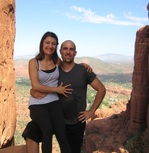After a quick and uneventful drive back to Delhi, we parted ways with our driver and caught the Shitabi Express train to Amritsar. The train was super comfy and we were served snacks, water, dinner, and dessert! Our travel agent had arranged for us to be picked up at the station, for which we were so thankful as the place was so full with people sleeping on the ground everywhere, that there was hardly anywhere to step on the floor. After sleeping in and resting, we started exploring the first of three religious practices we would encounter within just a few days.
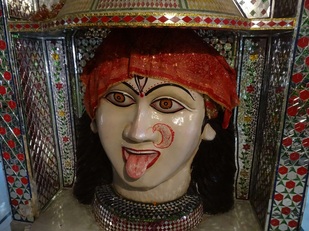 Mata Temple Statue Hinduism is the most common religion within India, though it covers many different practices throughout the country and is said to be more of a traditional way of life. It is also thought to be the oldest living religion as it draws its roots from the Vedic religion of Iron Age India. It is difficult to fully describe Hinduism within the scope of our blog because it is a conglomeration of multiple philosophical perspectives. But here are some core ideas. Hinduism generally sees the Godhead or Brahman, as represented by 3 personalities: Brahma (creator), Vishnu (preserver), and Shiva (destroyer). Some non-dualistic sects believe that the atman, or individual soul, is just an aspect of the Brahman and that the goal of practice is to realize this unity. Other dualistic schools see Brahaman as a separate being and believe that only by worshipping him in his various forms can freedom (moksha) be found. Most of the schools agree that humans are caught up in samsara (the continuing cycle of birth, life, death, and rebirth) and that through dharma (action in accordance with reality) people can find moksha. This dharma is represented by different yogas (paths or practices) like Bhakti Yoga (path of devotion), Karma Yoga (path of right action), Raja Yoga (path of meditation) and Jñāna Yoga (path of wisdom). Despite all this talk of freedom and unity, Hinduism has also incorporated into itself the socially rigid caste system. While barely addressed in key spiritual texts, the caste system has nevertheless become intertwined with Hinduism as it divides people into classes such as priest, warrior, merchant, laborer, or untouchable (outside of class).
Our exploration of Hinduism in India continued in Amritsar with a visit to one of the most unusual temples we have encountered thus far – the Mata Temple. Dedicated to the female saint, Lal Devi, this Hindu temple’s design is a labyrinthine path taking you to your knees through fake caves and through ankle high water on other portions of the “temple route”. The whole thing is covered in mirrors and colored glass as you pass by imagery of various devas like Shiva, Ganesh, black Bhuddas and even a saint with three breasts that reminded us of Total Recall! The experience here was more akin to a fun house than a place of worship, but at the end, we were mesmerized by the beautiful singing chants of the ladies in the main temple hall. We sat here listening quietly to their devotional calls and reflected on our experience here and in India, which is truly like a game of roulette in a casino. You never know what to expect here – one day, you are inspired by the devotion and spiritual dedication of the people and the next you are shaking your head as they blatantly lie to you about travel while you cover your ears to protect them from the constant honking and noise found on the streets.
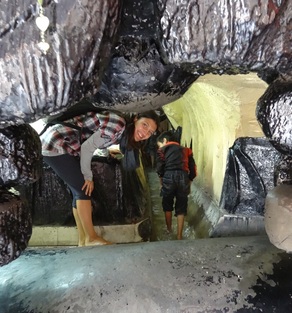
Walking through tunnels in Mata Temple
The next stop in our day was the heart of Amritsar, the Golden Temple, which is also the heart of the Sikh religion. This monotheistic belief system was founded in the 15th century in the Punjab region of India and this state remains largely populated by Sikh believers. In some ways Sikhism is easiest to define in its differences from Hinduism. It rejects the caste system and encourages nondiscrimination based on caste, creed, or gender. It encourages people to live lives as householders and not idealize the idea of the renunciant yogi who leaves all attachments to go find truth in the wilderness. To the Sikhs, God is present in everything and by meditation and right living one can break through maya (the false human view of reality) to find union with him.
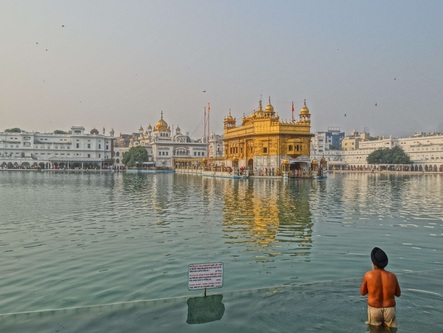
A Sikh Devotee bathing in the Pool of Nectar at the Golden Temple
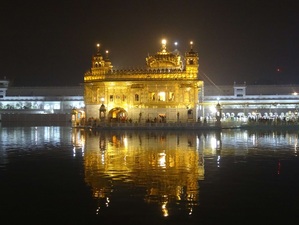 The Golden Temple is the biggest pilgrimage site for the Sikhs and every Sikh is expected to volunteer here for at least one week during their lifetime. The light shines brightly off of its gilded copper plates, all of which are situated in the middle of the sacred “pool of nectar”. Its dome represents an inverted lotus flower and gilding it took 750kg of gold! All day long, priests inside the temple recite chants from the holy book and loud speakers broadcast this throughout the complex. The most interesting experience was dining here. To honor their belief of the equality of all people, the Sikhs provide a free meal for all visitors. We lined up with the crowd and were continuously stared at unabashedly by the older Sikh men as there were not many ‘white’ visitors lining up to eat here. As usual, there were several people trying to get ahead in front of everyone by just pushing their way through. We found it terribly ironic that even in their most holy temple the Sikh people would be so impatient as to push ahead of others when there was plenty of space for everyone to eat. Once the hall cleared out from the previous group, it was our group’s turn to enter and the crowd swelled at the entrance of the double doors as people pushed and shoved to enter the empty hall and find a place on the ground. Once breathlessly seated, servers came by with buckets and served everyone a ladle or two of different kinds of dal, some type of curd, and roti. Sometimes it seems that regardless of religion, the booming population in India has made everyone act like dogs fighting over the last bone. We did find that the Golden Temple was much less hectic at night and enjoyed walking around the pool of Nectar to the soft sounds of chanting over the speaker.
The city of Amritsar was a bit stressful so we decided to head to Dharamsala a bit earlier to breathe some clean air in the mountains and get ready to see the Dalai Lama! Dharamsala rose to fame in 1959 when it became the home of the Tibetan government in exile and the 14th Dalai Lama. We found out he was teaching during our visit to India, so we decided to go up North before it gets too cold to see him. This brought us to our third religious encounter – Tibetan Buddhism. As opposed to our practice of Zen, which founder Bodhidarma espoused to be “a special transmission outside the scriptures, not relying on words and letters,” Tibetan Buddhism appears to emphasize the oral transmission of teachings and utilizing these teachings in analytic meditation. Tibetan Buddhists are encouraged to engage in internal debate over the oral teachings and alternate between this analytic meditation and calm abiding meditation. Another major difference in Tibetan Buddhism is the use of Tantric (Vajrayana) practices to attain enlightenment in a single lifetime.
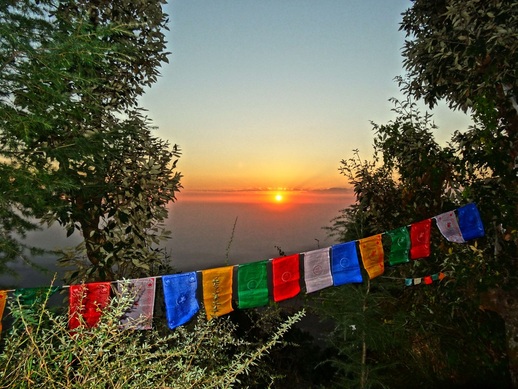
Beautiful sunset behind the Dalai Lama temple
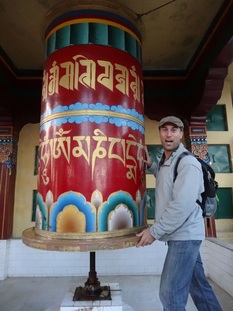 Spinning the huge prayer wheel The Tantric practices are not shared with uninitiated disciples, which has to be done by a qualified lama. While we don’t necessarily connect with these aspects of the religion, it is a very colorful form of Buddhism with beautiful mandalas, prayer wheels, and chanting seen and heard all over the temple.
While in Dharmsala we enjoyed circumambulating around the temple at sunset, with amazing views of the Himalayas in the background and Tibetan prayer flags in the foreground. We took a day trip to the nearby Bagsu Waterfall and drank delicious lemon-ginger-honey tea at the Shiva café while the young backpackers next to us chatted nosily in a ganja induced state. We enjoyed looking at the wonderful crafts the Tibetan refugees had crafted like turquoise covered prayer wheels filled with thousands of repetitions of the compassion mantra or the delicate Thangka paintings, which are sacred mandalas painted onto cotton.
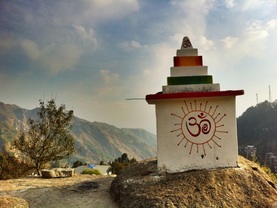 Beautiful stuppas on the hills above Dharamsala The whole process of preparing for the teaching ended up offering a bit of a laugh in the end. We spent one morning registering for it and next day arriving early to pick out our seats for following day’s teaching. Then, on the morning of the teaching we arrived two hours early to wait. The Dali Lama entered the building and settled down on his seat and began to teach. It was then we discovered that the FM broadcast of his teaching in English didn’t work on the side of the temple we were on! We eventually moved, but still the translation wasn’t great and the teachings on the Lam Rim text proved too convoluted to capture our interest. But the experience of seeing the famous leader and teacher alone was interesting. He is smaller than I had thought but quite jolly as he appears on many photos. He likes to make some jokes while lecturing and is quite animated using many hand gestures when he teaches. At one point during his exit, we were so close to him that we could touch him (but we are pretty sure the guys with the big guns would not have been happy J!). He always tried to embrace people as he entered and left the temple and his presence inspired smiles and happiness.
After a relaxing time in Dharamsala, we took an overnight bus to Rishikesh, the self-proclaimed yoga capital of the world. More accurately we came 2km north of the town of Rishikesh to where the ashrams and yoga centers are – an area called Swarg Ashram and Lakshman Jhula. The area is littered with posters advertising many different yoga centers and teacher trainings for Westerners. We have attended some classes and looked into staying at some of the ashrams, but in truth all the classes just left us really missing our teachers in Austin. Teachers here are prone to make rough adjustments that can easily lead to injury, don’t properly warm-up students, and teach sequences of postures that are generally less creative than what we found in Texas, strange as that sounds. What was once a relatively isolated place of pilgrimage for Indians looking to meditate on the sacred Ganges has become a cluster of guesthouses and restaurants, all with multi-national menus serving white folks.
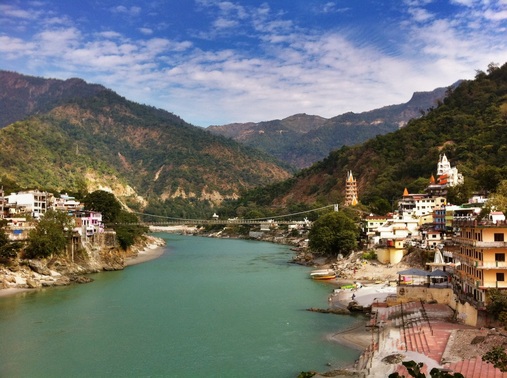
Ashrams and hotels in Rishikesh overlooking the Ganga
That’s not to say that there aren’t Indians here. The area is crowded with pilgrims and this combined with the yoga seekers has led to an overdevelopment that leaves the streets congested with honking taxis and motorbikes, leaving one’s ears buzzing after just a few minutes in the street. Despite all of this, it can’t offset the beauty of the Ganga at sunset or of the river itself.
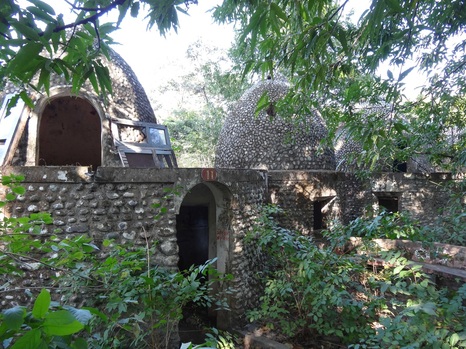
Meditating capsules
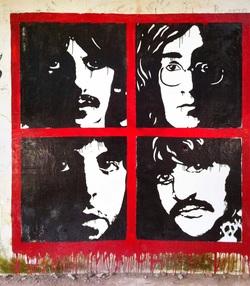 One interesting bit of history lying in ruin in the forest near Swarg Ashram is the enormous ashram of Maharishi Mahesh Yogi, the founder of Transcendental Meditation (TM). The self-proclaimed Maharishi (enlightened one) hosted the Beatles at this ashram in 1968, where they are said to have written parts of the White Album. But their stay was somewhat short-lived amid accusations of sex-scandals and profiteering by the Maharishi. TM has continued as a money making force however, and when the Maharishi died in 2008, his estate is said to be worth anywhere from 600million to nearly 2billion dollars. The ashram lost its lease on the land in 1997 and has since yielded to the forest, making for a fascinating walk through what was once a hippie style wonderland. There are hundreds of little round capsules where devotees could live on the bottom and perform meditation at the top. The complex includes many deteriorating dormitory style buildings as well as a large auditorium (since made into a shrine for the Beatles – see pic above) and the Maharishi’s old home.
This is one of our longer posts and as you can see, it is full of mixed emotions. What spiritual perspective have we been taking on this whole experience? On the one hand, the constant strain of being out in public in India has taken a toll on me as a woman. When it’s not the aforementioned noise, it’s the leering looks of the men as you walk by and the occasional grope that they try to pretend was a stumble. Combine that with the dirtiness of the place and it makes me just want to get out of here. But Jeff and I have reflected that in some ways the whole place is like a container in which you are uncomfortable to be and the only way to find peace is to accept the situation, not fight against it. In such places, you must confront your ego and either work towards loosening its grip on your outlook or find yourself in even more pain. Maybe that is why India is the heart of so many powerful spiritual practices while simultaneously being such a trying place to travel within! The pics from these three towns are on flickr - http://flic.kr/s/aHsjD17oST.
As we traveled from Agra to Jaipur, Neda and I were still feeling exuberant from the amazing sites of the day, but were starting to grow restless at the one-dimensional relationship we seemed to have with every Indian person we met. In Delhi and Agra we found that every single interaction we entered into culminated in someone asking for money, for us to buy from their store, or was some other attempt to extricate money from us. 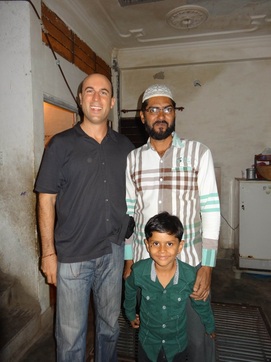 Jeff with Saleem and his son Kabir In Jaipur, that all changed. We had sent out some couch requests on our favorite website Couchsurfing.org. Some people warned us this was a bad idea in India, but CS’s format of screening people through past references has always worked well for us and it seemed that India was a place where we would really benefit from having some authentic interactions. We were accepted by Saleem Khan and his wonderful family, who live in a 300 year old home in the old city of Jaipur. I can tell you that our driver seemed pretty surprised when Saleem met us at one of the city gates and then spoke to him briefly in Hindi before leading our car through the winding alleyways that led to his family home! Once at the house, we were greeted to delicious chai (black tea, milk, and a bit of sugar) and mutton briyani, complements of the various ladies who live in the house. Saleem’s house is bursting with the energy of family – himself, his wife and kids, as well as his mother and various brothers and sisters and their family all live there.
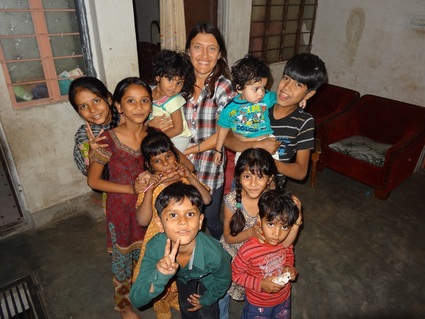
Neda with all the kiddos!
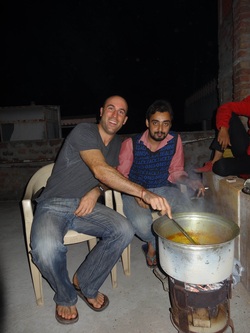 Jeff cooking up a storm! In total, 15 people reside here daily and even more were in town for the Diwali festival as guests. We were among those guests and loved the time we spent playing with the children, talking over chai with Saleem and his genial brother Kabir, and watching the workings of the bustling household. On our 2nd night there, we were invited to help cook a delicious Mutton Korma from scratch, watching as cooking expert Jeckie cooked down the onions in ghee, added a variety of fresh spices, mutton, and milk in order to create a creamy and spicy delicacy. We ate the meal on the family’s rooftop, where a typical night of winter dusk sees thousands of kites being flown by children from the rooftops and where during the Diwali festival the sky erupts with fireworks launched from all over the city.
During the days we did sightseeing with our driver. He drove us up to the picturesquely situated Amber Fort – which lies on a hilltop 11km outside of town. Built in 1592 by Maharaja Man Singh, a general of Akbar’s Army, the fort boasts the furnishing of a palace, with the impressive Jai Mandir (Hall of Victory) inlaid with mirrors along with intricate carvings that catch the eye in a thousand places. Amber Fort is watched over by the even higher situated Jaigarth Fort. Jaigarth’s interior is not as impressive as Amber, but the watchtower there affords splendid views of Amber and surrounding countryside. On the way back from the two forts, we stopped at the Jal Mahal (water palace), a beautiful sandstone building which seemingly floats in the middle of a dam-produced lake that was created in the 16th century. It is said to have been created to house the Maharaja’s harem so that they would be separated from all possible corruptions.
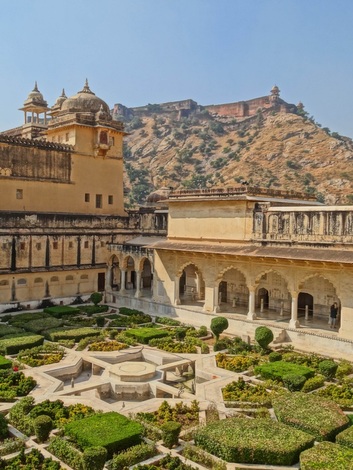
Jaigarth Fort view from Amber Fort's gardens
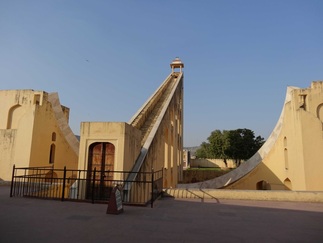 Jantar Mantar Observatory - biggest sundial Heading back into town, we visited Jantar Mintar, the royal observatory. It consists of an open-air plaza full of giant instruments that take varying measurements of the nighttime sky, including the most massive sundial we have ever seen, the 90m high Samrat Yantra. Using all the different instruments together, has the ability to glean a comprehensive picture of the celestial sky. Across the street from Jantar Mintar is the City Palace, the home of the Rajasthani Maharajas ever since Maharaja Jai Singh decided to move from Amber Fort and founded the city of Jaipur. It contains a textile museum explaining costumes of the region and rulers over the years as well as an interesting hall showing the history of the different Maharajas from scholar kings to warriors. At Pitam Niwas Chowk square, the beautiful painted peacock doorways enchant visitors while the private royal palace of the Chandral Mahal looms in the background.
The main event was the night of the 13th, the celebration of Diwali. Diwali, or the festival of lights (http://www.diwalifestival.org/diwali-new-year.html), marks the Hindu New Year and is one of the most major celebrations in India. Hindus believe that Lakshmi, the Goddess of wealth and luck, visits home that are brightly lit and so the whole city comes alive with light. Children make “deeps”, or small clay lamps to attract the goddess to their homes in the hopes of new clothes and toys. In Jaipur, Diwali is taken beyond just individual homes as the city’s many bazaars are garishly decorated and illuminated in a display that makes Christmas look like childsplay!
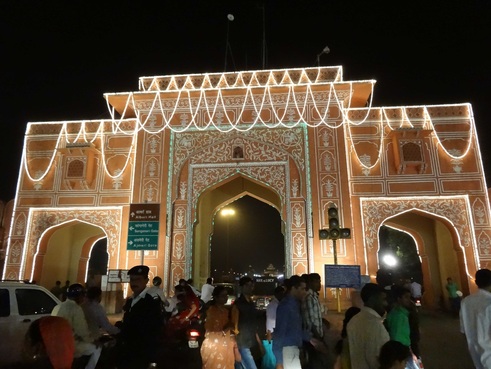
Jaipur City Gates decorated for Diwali
On Diwali night, our host Saleem and one of his good friends Asif honored us by driving us through the whole city on their motorbikes. Neda sat behind Saleem and I sat behind Asif as we cruised from bazaar to bazaar watching the kaleidoscope of lights. I think the star of David is also an ancient Hindu symbol, because some streets were just lined with hundreds of them, confusing me for a moment into thinking it was a different festival of lights! The gates of the old city were also lined with lights, making for a dazzling entranceway into the bazaars. We rode alongside whole families on single motorbike (with the women and girls dressed up in their fancy Diwali dresses) and behind autorickshaws packed with 4 or 5 kids in the back, their slack face jaws staring out at the iridescent scene. Jeff managed to take a few videos of the whole scene, click here to see one of them and the rest are on flickr. For a little while as we cruised along the streets, we blended in with the crowds and felt like we were a part of the whole scene and not just tourists there to observe from the outside. This was the most precious gift that Saleem and Asif could give us.
After leaving with a joy from Delhi, we left Jaipur with heavy hearts. In just a few days we felt like we had become a part of the family, and we knew we would miss the close knit community that Saleem was a part of. It really contrasts with our loosely knit family and friends – spread out everywhere from Philadelphia to Saint Louis to Boston to Austin to Bulgaria and another half dozen other countries as well. But for a brief moment to be a part of someone else’s quilt brought a warmth to our hearts we know will stay with us for a long time.
In 2012, we have celebrated 3 New Years so far. The Western New Year found us in a mountain lodge in Stara Zagora with Neda’s old friends, a raging fire and snow falling around us. The Thai/Lao New Year found us dancing in the streets of Luang Prabang, soaked to the bone with all the splashing water and a bit inebriated from the generosity of the local folk there. And finally, the Hindu New Year found us surrounded by a surrogate family amidst the glow of millions of lights. If that’s not what travel is all about, I don’t know what is! To see all our pics (and videos!) of Jaipur and Diwali – click here: http://www.flickr.com/photos/67011297@N07/sets/72157632011293721.
If you read our previous post about New Delhi, you would know that we were feeling pretty harried with all the machinations required to book our travel through the “Golden Triangle” of Delhi to Agra to Jaipur and back. After many attempted scams, our driver did arrive on Saturday morning and we felt a swelling of relief that the ordeal was over. The driver, Rimesh, seemed like an affable fellow who spoke good English. He was telling us about how his family lives north in the mountains and how he works in Delhi to support them. Then, he pulled over on the side of the road and said, “My wife only visits a few times a year from the mountains and one of those times is during Diwali (the Indian Festival of Lights). So my cousin Kirssna will be your driver. We’ll just pull over here and pick him up.”
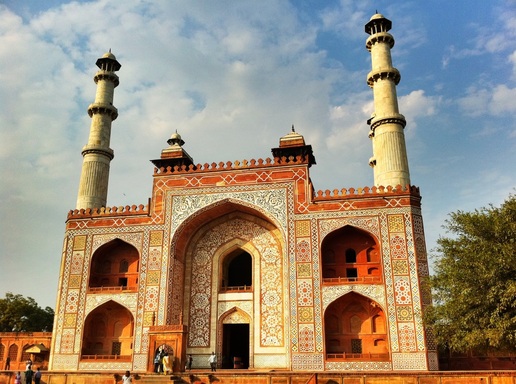
Akbar's Tomb - Sikandra
Uh, oh. Our frazzled nerves from the previous few days had us wary of any changes that we hadn’t been told about. But we had little choice and a call to our travel agent assured us it wasn’t a problem. But in the end the change to Kirssna as a driver seemed to shroud the whole journey under a veil of bad luck. Kirssna spoke much less English than his cousin and as we petered out of traffic-congested Delhi with mosquitoes flying through our car, we discovered upon closing the windows that our “air conditioned” car had no working AC. Kirssna attempted to get it fixed at a road side shop, but in the end this only succeeded in killing off the alternator, leaving us broken down on the side of the road about 45 minutes from Agra. After a sweltering 2 – 3 hour wait for the waiting for a different car sent by the travel agency to pick us up, a 4-6 hour journey had ballooned into a 10 hour one and we were exhausted.
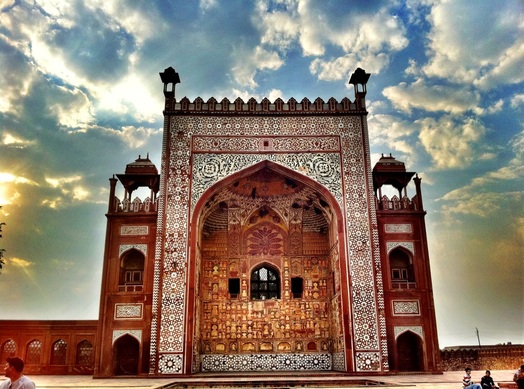
Akbar's Tomb as the sun starts to set
Still, the drivers of the new car at least gave us a taste of what the region had to offer as we stopped in Sikandra to view the tomb of Akbar the Great, the Mughal Philosopher King who was uncommonly tolerant of different religions and viewpoint within his realm. He penned a philosophy known as Din-i-llahi (Faith of God), that spoke of the unifying thread of truth found in all religions. His mausoleum, which predates the Taj Mahal by several generations, is an imposing and delightful blend of red sandstone inlaid with marble geometric patterns that harkened us back to our travels through Andalusia. Though we hadn’t anticipated seeing it so late in day, as the sun set over the ancient tomb the sandstone blazed forth as if on fire and the visual effect was such that we instantly felt glad we had continued on this journey that seemed plagued with problems. That sentiment quickly eroded as, despite our exhaustion, the drivers insisted on taking us to a marble making shop, where an interesting description of the techniques used at the Taj Mahal to inlay the marble with semi-precious stones (called pietra dura) was followed by a harsh and hard sell by the shopkeeper. Insisting we were too tired to even think of shopping, we left the shop with a curse at our backs and feeling that the goodwill in India was in short supply. We were unceremoniously dumped at our hotel and our failed calls to our driver left little choices for dinner save the Pizza Hut next door. Just a few days in India and we were already eating at our second chain due to simply being unable to find authentic restaurants! It was fun however, to see the unique Indian items like the Spicy Paneer Quesadillas and Chicken Tikka Masala Pizza. We headed to bed early in anticipation of our sunrise viewing of the Taj.
As morning came, we sat outside our hotel futilely trying to contact our driver. Realizing he wasn’t coming and that we would miss the sunset, we hired a private rickshaw and headed to the Taj ourselves. The sun was just lifting from the sky and we trundled through the massive red sandstone gate to get our first glimpse of this wonder of the world.
And a wonder it is. The great Indian Poet, Rabindranath Tagore once likened the Taj to “A Teardrop on the Face of Eternity”. We stood gazing the at the wondrous sweeping curves of its onion-like white marble dome glowing sweetly to greet the new day. Its towering minarets stand guard over the tomb of Mumtaz Mahal and the view of the background sky is totally clean due to the huge elevated marble platform the Taj sits upon. The tourists surrounding us fell away. Time fell away. And for a moment there was just the beauty of this thing captivating our minds, flowing through our hearts.
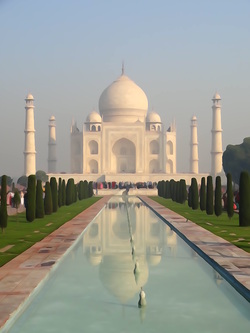 The Taj Mahal was built by the great Mughal builder Shah Jahan upon the loss of his wife after the birth of their 14th child. It took 20,000 craftsmen and workers from all over the world 22 years to finish the masterpiece – a building meant to represent the heavenly realm where Shah Jahan’s wife rested. In this way, it had parallels to the gorgeous palace of the Alhambra, which was an attempt by the Sultans there to create heaven on earth. What is most striking about the place is not something that can be captured in pictures. It is the juxtaposition that strikes one when in its presence. It both instills a deep peace at its beauty but also calls forth the yearning for love each of us feels – that makes each of us human. After the ordeal of the past few days, it felt like the Taj gave us that gift – it made us feel human again. We found ourselves laughing and joking as we left, energized by the visit and determined to feed our pain bodies no longer, but to embrace this trip no matter what it brought us.
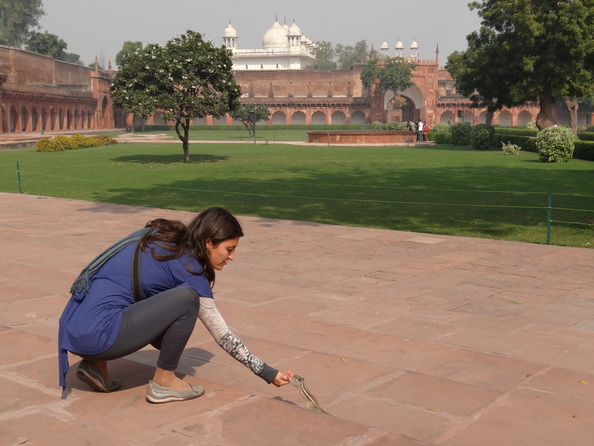
Neda greets a chipmunk from within the palace complex of Agra Fort. The Sultan's Mosque sits in the background
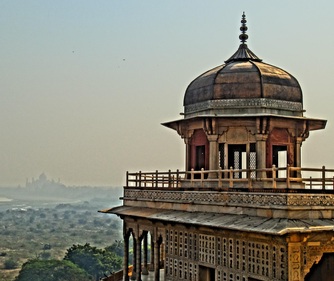 Nice view for a prison The rest of the day breezed by with a stream of marvelous sites. We finally located and were picked up by our driver, got a great breakfast of boiled eggs, herbed parathas, and dal in our bellies, and headed to Agra Fort, built by the aforementioned Akbar and retrofitted by his grandson Shah Jahan. Like the Red Fort in Delhi, Agra Fort started as a military base and later became a palace where royal affairs were carried out. Perhaps the most striking building at the fort was the Khas Mahal, a wonderfully carved marble palace that became the prison of Shah Jahan when his son Aurangzeb seized the throne and threw his father in prison. I found great irony in this because Shah Jahan is said to have immediately slain all competitors to his throne upon coming to power. But despite all this violence and grasping, his own karma came back to haunt him as the one person he wouldn’t slay, his son, seized the throne from him. His perch in the palace-turned-jail, however, did provide a stunning view of the Taj over the Yamuna River where Shah Jahan could look at his beloved each day.
From Agra Fort, we headed 40km west of Agra where we stopped at Fatehpur Sikri, an abandoned city built by the ubiquitous Emperor Akbar. Akbar built this city out in the boondocks in honor of the Sufi Shaikh Salim Chisti, who had prophesized here that Akbar would father an heir to the Mughal throne. When the prophecy came true, Akbar set out to build this “perfect city” of good fortune and move his capital there. The plan only lasted for 15 years, after which Akbar died and the chronic water shortages of the area left the city abandoned for the more consistent water supply that had existed in Agra.
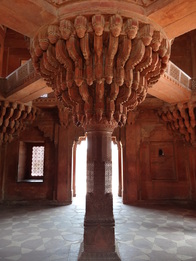 Diwan-i-Khas The result is an eerie city that had become a ghost-town within the same generation it was constructed. Our favorite site in the palace complex of the city was the Diwan-i-Khas (Hall of Private Audiences) with its intricately carved planked ceiling connecting a grouping of “wasps nests” at the 4 corners of the room and in the center. The hall was used for one of Akbar’s favorite pastimes – religious debate and discourse. We also loved the Panch Mahal, a five-story pavilion that reduces in size each floor until only a small gazebo remains. From there, Akbar relaxed while playing pachisi using his slave girls as pieces. This guy was certainly living up an Emperor’s life!
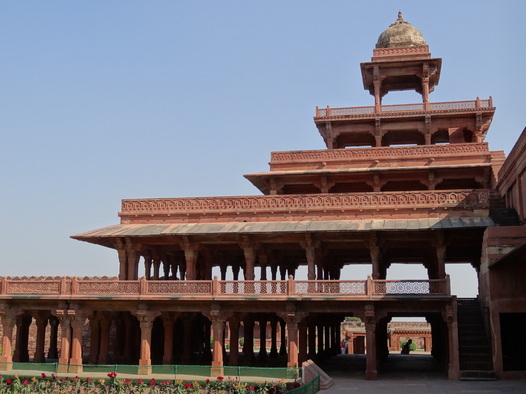
Panch Mahal - from the top the Emperor presided over giant games of pachisi in the courtyard with his servant girls as pieces!
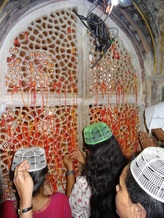 Finally we left the palace complex and headed to the great mosque of Jama Masjid, which contains the beautiful white marble tomb of Shaikh Salim Christi. His descendants still maintain the tomb and it is a flocking point for pilgrims wishing to bear children. Wishing for the good fortune the Sufi saint bestowed upon Akbar, they come to his mausoleum to offer prayers and tie little red strings around the lattice-work marble screens surrounding his tomb.
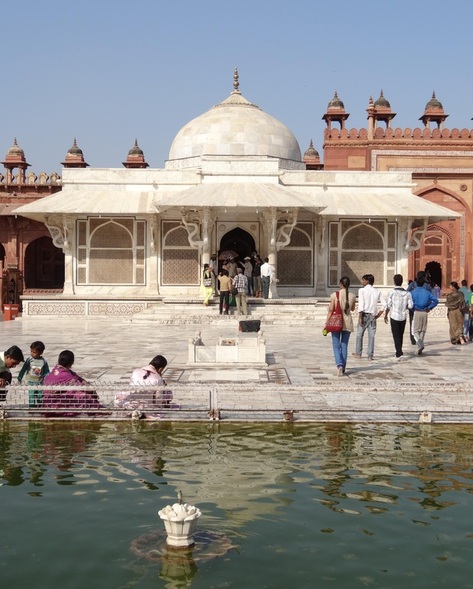
The Marble Tomb of Shaikh Salim Christi
By the time we got back into the car and started our 5 hour journey to Jaipur, we were exhausted but invigorated. The remains of the Mughal empire around Agra were a legacy of beauty, the celebration of life, and the many reminders of its impermanence. We looked forward to the next stop in the Golden Triangle, where we would celebrate Diwali in the Pink City of Jaipur and try out Couchsurfing in India for the first time!
Ahhh, India. Literally landing there was like stepping into a new world. A really, really dirty one. Upon exiting from the plane at 6am, our throats caught at the stringing sensation of inhaled smog. Our morning taxi ride to our hotel was like driving through a war zone of slowly awaking people along the roadside and a haze that seemed to set an implacable gloom over the whole city. We spent a few hours planning our onward journey, but were puzzled by seemingly fully booked trains and hard to reach bus stations with little information. So we took a brief nap and decided to worry about all that after our first foray into an Indian city.
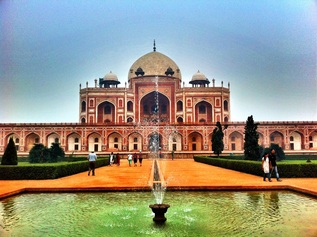 It started positively with a local restaurant serving delicious Punjab food. We were salivating over our perfectly spiced Aloo Gobi (potato and cauliflower curry), Mutter Paneer (green peas, cubes of pressed white cheese, and a creamy tomato curry sauce), and garlic naan. We got ourselves an Indian SIM card and set off on the Delhi Metro (the most crowded we have ever experienced) to Humayun's Tomb, the mausoleum of the son of the great Mughal Emperor Babur who had conquered Northern India from Kabul, Afghanistan in 1526. The tomb is an impressively massive structure built out of red sandstone and white marble – a merging of Persian and Indian influences. But the heavy fog combined with the smog nearly smudged out the sun and left the view slightly less mesmerizing.
With a bit of time to wander in the evening we headed for Connaught Place, which lies in the center of New Delhi. It was the beginning of things going downhill very quickly for us in Delhi. We had read that the Deli Tourism Authority was in the area, but it was over an hour since it was supposed to have closed, so we just wandered around the various rings of streets emanating out from the center where the metro stop was looking for restaurants. At one point we turned and saw a place labeled “Delhi Tourism Authority” with an “Incredible India” symbol on its frosted glass door. I said to Neda, “oh, look there is the Tourist Office – is it still open?”. We pushed on the door and it looked like they were about to close, but one man there gestured for us to sit and said he could stay open a bit longer.
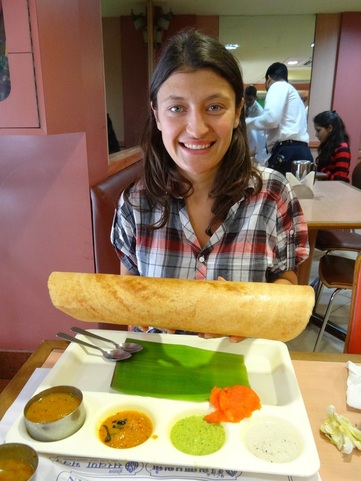
Mmmm...that is a big dosa! We ate at the two restaurants pictured here and above 3x each!
We just wanted information on transportation options out of the city to Agra (home of the Taj Mahal) and then onward to Jaipur, the Pink City. Known as the “Golden Triangle” this popular tourist route covers many major sites in India. The man proceeded to sweet talk us into listening to him entirely too long, planning out a whole itinerary and offering to book trains for us that we knew were full, before I asked, “Is this the tourist office? Because it seems more like you are a travel agent.” He then lied to my face and said, “Of course, you didn’t know the Delhi Tourist Office offered these services?” Well, those services came to over 400 euros per person for things he couldn’t possibly fulfill. We wisely left without paying a dime, but tired of having spent much of the day trying to plan our escape from Delhi with no success. We resolved to finish the task the next day without any more scams.
We headed off to the train station the next day, where we had read you could book trains directly and find out if any of the trains had seats remaining with a “tourist quota” that couldn’t be purchased online. The tourist office for this was supposed to be on the second floor. When we entered the train station, there was a barrier in front of the steps and a man approached us to tell us that the tourist office was closed for repairs but that we could buy the reserved tickets at the Tourism Office. He kindly pointed to where it was on the map and told us to have a good day. Since he hadn’t asked for anything we took him at his word and headed back to find the real Delhi Tourism Office. We rode the subway the one stop back to Connaught Place and as we were exiting a man walking along side of us started a casual conversation with us, asking what we thought of the Delhi Metro. As we continued to walk with him alongside of us, he found out we were going to the tourist office and said that it could be difficult to find because of all the fake offices. He said he was walking right by it though, and could point it out to us. Well, you may have guessed by now that this man had followed us (I know freaky!) from the train station and was just playing us to get us to yet another fake tourism office! This one was located on the same street as the tourism office (see pic below), making it difficult to know which is real since there are no street numbers anywhere!
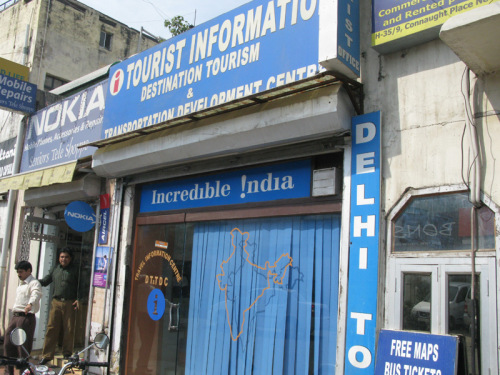
The fake tourist office we were led to the 2nd time...notice the "D.T.T.D.C" on the door - the real initials of the tourist agency are "D.T.D.C." Pretty tricky, huh? Photo courtesy of leave me here: http://leavemehere.wordpress.com/2009/10/27/destination-india/
After another rigmarole with some similar themes as the previous time (“do you want to go to visit Kashmir and stay with a family there?”), and an inability to give us good information on public transport without planning a trip for us, we wisened up to the fact that this wasn’t a real shop and fled again, feeling foolish and exhausted (though at least not robbed!). Finally, we found the Government of India Tourism office on 88 Janpath road, the only office with a number marked on it! The man there told us that many of the trains and buses would be difficult to procure during this busy time (the popular Diwali Festival starts on Nov. 13th), but suggested we try a real travel agent who was next door or go back to the train station and try our luck again. Exhausted at this point, we went next door and finding a government licensed tourist agency, Destination India, we simply paid the extra money to hire a driver for 5 days to take us to Agra then to Jaipur and back to Delhi before leaving on a train to Armirtsar, home of the Golden Temple. Coming in at just about $45/day including two nights of hotels as well, it seemed just a heck of a lot easier than dealing with the congested and seemingly dysfunctional public transportation around Delhi.
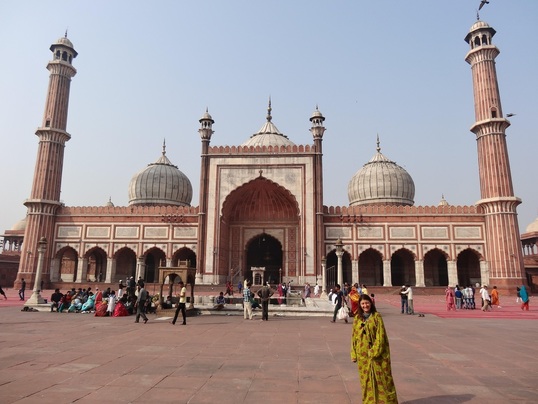
Neda sporting her moomoo at Jama Masjid Mosque in Delhi. Personally, I thought she looked good in puke yellow...
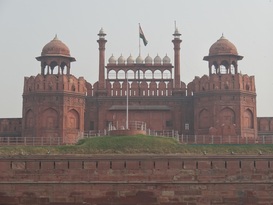 The Red Fort That night was a difficult one for us as we marveled and mourned at how elaborate the schemes were to trick us and rob us. We felt we couldn’t trust anyone in the city and just wanted to get out. We crossed our fingers that our driver would show up the day after next and vowed to enjoy our last day in Delhi, which we did. We visited the massive Jama Masjid mosque where Neda was forced to don a hilarious moo-moo that steamed her like a dumpling under the mid-day heat. Then we visited the Jain temple Lal Mandir, with its accompanying bird hospital. The Jain religion, originating around the time of Buddhism, holds the tenant of ahimsa (non-violence) as paramount and the bird hospital is seen as an embodiment of that. There, the caretakers rehabilitate everything from pigeons to peacocks that the faithful bring to them when found wounded.
Finally, we visited the Red Fort, a palace built by Mughal Emperor Shah Jahan (who also built the Taj Mahal), where we saw the scattered remains of the red sandstone and marble structures that once held a small city within a city. The next day we woke up early and our driver was waiting for us outside the hotel. Yay! We weren't a scammed – or were we!? Read about our crazy trip to Agra next… To see all the pics of our time in Delhi, click here:
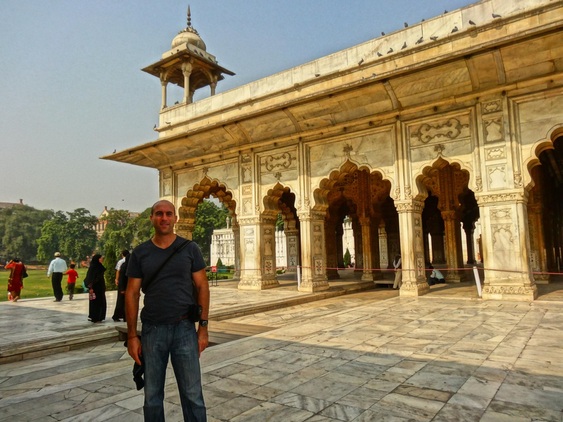
A flowing river of fresh water once flowed through the canal in the background through the palatial buildings of the Red Fort
What I remember most from my childhood in Bulgaria is the summers, when we were off school and roamed the neighborhood all day long. One of the people that always accompanied me was my friend Tania, from our apartment building. We spent our days sewing clothes for our dolls, planning elaborate picnics in the nearby fields, even attempting to smoke her mom’s cigarettes. Tania and I were inseparable for many of these years, until my parents immigrated to the United States in 1997. The internet was just becoming more common but nobody in my country had a computer or email, so our only way of connecting was through the phone or through mail. This left most of my friendships on hold until I reconnected with some of them, including Tania, through email addresses I acquired nearly 10 years later on my first trip back to visit Bulgaria.
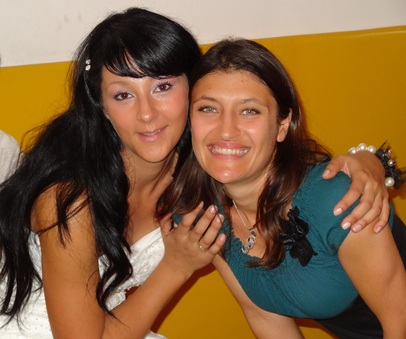
Tania and I at the wedding
We had the chance to spend some time with Tania and her husband Georgos last winter, when they were back for a visit in Bulgaria. This was the first time we saw each other in 15 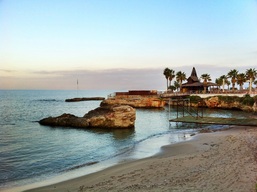 Star Beach on Crete years! We found out more about her moving to Crete and meeting the father of her adorable little daughter Marilena. At that dinner a year ago, they invited us to their wedding, and we vowed to attend despite any logistical hiccups that might arise getting to a fairly remote island like Crete. For me it was important to not let our ties wither again as they had when I departed for America all those years ago. Also, their wedding on the island was a great way to start the next leg of our adventure.
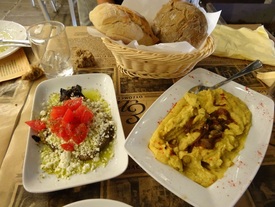 Delicious Greek food in Thessaloniki The best route down to Crete first involved a 9 hour bus trip to Thessaloniki followed by a domestic flight from there to Crete. It was impossible to do in a day, so we made a stopover in Thessalonki to explore the second largest city in Greece. We found a rich history from its 3,000 year existence as part of the Roman, Byzantine, and Ottoman empires. We visited the beautiful White Tower on the coast, the ancient mausoleum turned church in the Rotunda, and the ruins of the ancient Roman Forum. We came upon a cute tavern, the only bustling restaurant along the seafront promenade. Most people eating here were Greek, so we decided to give it a try, were in for a wonderful surprise. Platters of pureed fava beans, roasted eggplants and vegetables covered with tomatoes and herbs, chickpeas with traditional sausages, veal chunks surrounded by a mote of creamy eggplant puree, and delicate feta cheeses crowded our table along with dry red wine and tsipouro (a drink similar to Bulgarian rakia). The assortment of tapas style dishes left us stuffed to the brim and thankful for one of the best meals on our travels thus far!
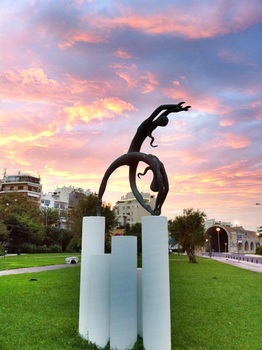
Fiery sunset over this statue in Heraklion, Crete
The next day, we flew to Crete to meet the bride and groom! We spent the days before the wedding hanging out with their family (where Jeff could practice his Bulgarian) and enjoying home cooked meals from Tania’s mom! She spoiled us with Greek and Bulgarian dishes every day and made us enormous salads covered in homemade olives from Georgios’ mom here in Crete (which were by far the best olives I have ever tasted!). We played with Marilena, their beautiful 2 year old daughter, and marveled at how she could transition from Bulgarian when speaking to Tania, to Greek when speaking with Georgios. We took a day trip to Heraklios, the capital city of the island, and visited the old Knossos ruins of the Royal Palace of the Minoans (the place where King Minos is said to have lived, where the Minotaur was spawned and later killed by Theseus, and where Daedalus and Icarus took forth on an ill-fated flight from the confines of the nearby labyrinth). The ruins were different than many we have visited because the site was partially restored by an archeologist named Arthur Evans in the early 1900s. He interpreted the spaces he found and built over them as he thought their function was intended, which was quite controversial in hindsight since many of his assumptions were probably wrong. The site left us disappointed on one hand as it was difficult to differentiate true 4,000 year old ruins from reconstructions, but also thankful for some of the replica drawings he posted all around and the reconstruction’s vision of what life in the palace may have been like.
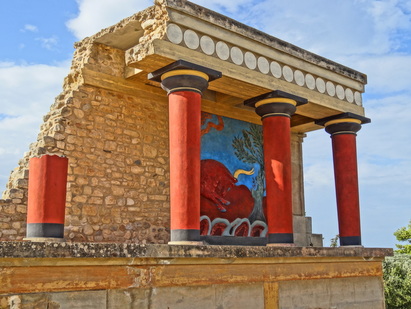
Bull painting and reconstruction at Knossos
The culmination of the trip was the Cretan wedding. Crete is the largest and most populous of the Greek isles and was once the center of the aforementioned Minoan civilization, which is 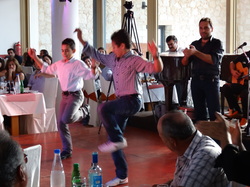 Pentozali dancers the oldest recorded civilization in Europe. The wedding was a traditional Greek Orthodox wedding combined with the baptism of Marilena. After a short ceremony in the church for the wedding and then the baptism, the guests were showered with delicious food and Cretan wine. The Cretan sheep cheese was exceptional and we enjoyed all the different meats and accompanied side dishes, like the creamy Cretan rice pilaf served with baked mutton. Perhaps most interesting was the live traditional Cretan band playing the Cretan lyra and the laouto. The music was accompanied by a traditional dance, the Pentozali, performed by the guests. The dance would start like a Bulgarian horo, in a circle, with everyone following the same steps. Somewhere along the line, the first person in the horo, usually a man, breaks off into a solo dance performing a series of jumps while smacking the bottom of his shoes. Some women also performed solo dances in the middle of the circle involving dips and turns.

Marilena, all prettied up for her baptism
It was fascinating to watch these ancient dances and customs being passed down from generation to generation and preserving the bond these people share with their past. It was also warming to be part of the wedding of one of my best friends from my past and to renew the bond we have shared for all these years. Like the Cretans, who take pride in their past and celebrate the history that makes them who they are, I felt a deep gratitude for the ties of my own past and my ability to celebrate them with an old friend on a special day in her life. As Marilena just learned to say this weekend, “Zhivi i Zdravi!” (To Life and Health!) Click here for our pics from Thessaloniki and Crete.
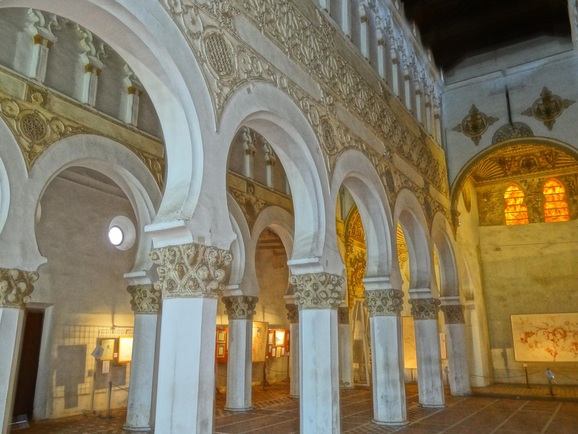 One of the oldest synagogues in Europe, Santa Maria la Blanca was converted to a church after the Jews who worshiped there were murdered by their neighbors in Toledo In our post on Andalusia, we started the story of the Jews in Spain during the rule of the Moorish Kingdoms. As we traveled to the central region of Spain to visit the capital of Madrid, we will end that story. Previously we learned that the Moorish Kingdoms were tolerant of the Jews, creating a golden age where Jewish culture and art thrived. But as more conservative factions came to rule in Moorish Spain, Jews fled to the territory of the Christian Kingdoms, where they were not killed largely because those kingdoms needed them in the fight against the Moors. 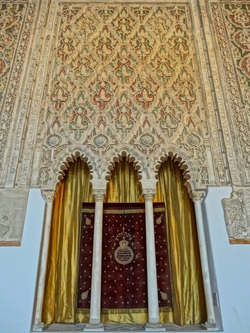 The Ark in El Transito Synagogue Much of the history comes to a head in Toledo. In 1085, Alfonso VI welcomed the fleeing Jews to Toledo by granting Jews equality with Christians and even some rights of the nobility. 40,000 Jews served in Alfonso VI’s army against the Moors, until a key battle was lost in 1108. The Jews were blamed and a riot broke out that killed many Jews and saw their homes and synagogues burned down while Alfonso lay on his deathbed, helpless to stop the madness. For the next 300 years patterns like this would continue where Jews were given a modicum of power by one ruler, only to be massacred and exiled by the next. By 1391, anti-Semitism reached a fever pitch and Jews were butchered in Seville, Cordoba, and Toledo. Corpses of women and children lay heaped in the streets and in destroyed synagogues.
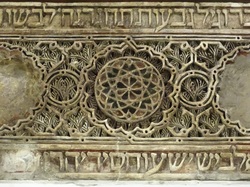 Stucco work - El Transito From the massacres rose to popularity the Dominican Vincent Ferrer, who forced Jews to either convert or be forced to live in ghettos where nearly any livelihood was illegal as was flight from the country. But as Jews did convert, no one believed their faith and hatred of these “New Christians” was the dominant attitude. Thus were sown the seeds of the Spanish Inquisition, aimed at finding out if converted Jews (conversos) were authentic in their faith. By 1492, hatred of Jews was so strong that Isabelle and Ferdinand signed the edict of expulsion, which forced all unconverted Jews to leave the country forever, with all of their property and wealth confiscated by the state. The majority (90,000) fled to Turkey and the Ottoman Empire while 20,000 others died in the process of fleeing. Those converses who stayed were subjected to the torture and persecution of the Spanish Inquisition, which didn’t fully end until 1834.
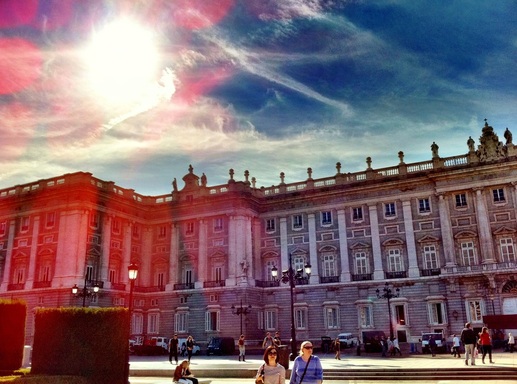 The Palacio Real burns under the midday sun But despite the sadness about the oppression of minorities in medieval Spain, there were many beautiful sites to be seen. In Madrid the Palacio Real (Royal Palace), the Botanical Gardens, and the numerous beautiful piazzas were all impressive. In Toledo, the mudejar style of the surviving synagogues was beautiful and the huge cathedral there is impressive. 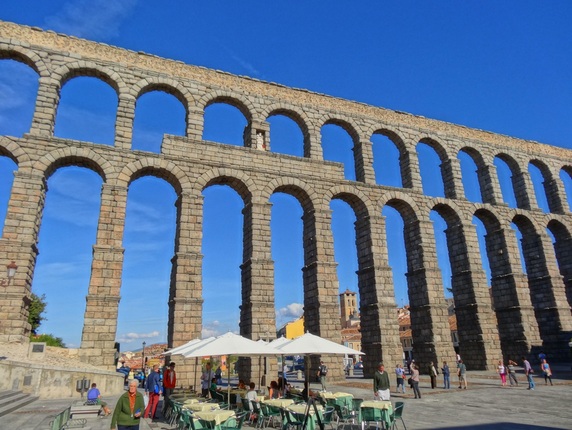 The extraordinary aqueduct in Segovia, outside of Madrid 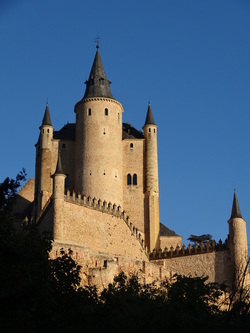 Alcazar in Segovia But perhaps most memorable for us was the picturesque town of Segovia, whose old city was fed by an aqueduct that reaches 28 meters at its tallest point. Built during Roman times to supply a fort on the hilltop that would become the city, the aqueduct uses no mortar (it is only stacked stones) and is truly an act of engineering genius, testified to by the fact that it still stands 2,000 years after its construction. It is amazing! The Alcazar (palace) in Segovia is equally beautifully – its Romantic style towers climbing into the sky on the site of the old Roman fort. Plopped down in the middle of the town between the Alcazar and Aqueduct is the last great Gothic Cathedral in Spain, also stunning. Walking down into the countryside in order to get views of the Alcazar and Cathedral as the sun set on the city was one of our favorite times in Spain. After the sun went down we sped home on our first trip ever on a high speed train – a mere 30 minute journey.
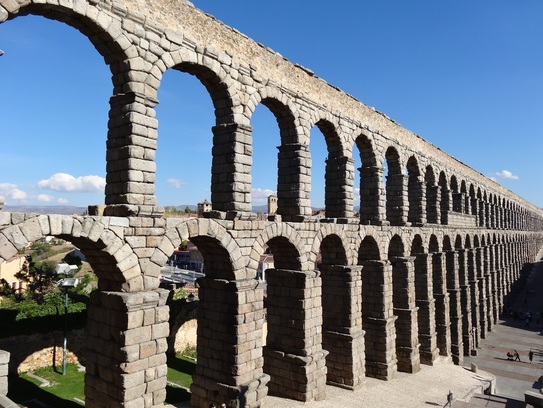 Can't resist putting in one more shot of this engineering marvel! 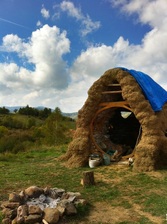 Mudhouse Postscript: We are back in Bulgaria now and getting ready for our trip to India. But if you want to see some pics of our mountain adventure in Bulgaria with our friends Kaloyan and Rumiana, click here. We had great times visiting a Bulgarian masterpiece of a house (from the days of Turkish occupation) and helping to build a hobbit-like mudhouse at the Future Now volunteer project high up in the hills. After getting back from our trip, we spent a 13 hour day making homemade lutenitza, inspired by our Barcelona friends Simona and Walter! If you are friends or family on Flickr you can click on the link to see the pics!
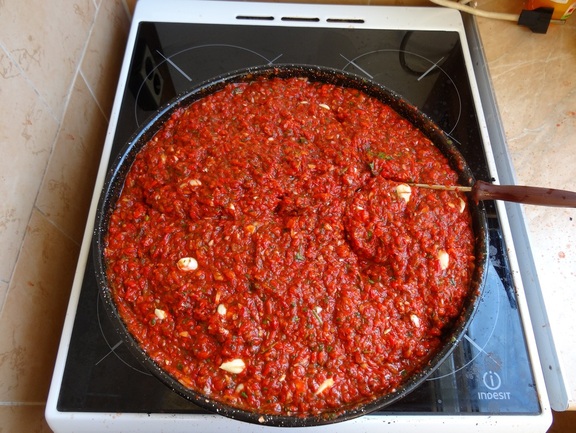 Homemade Lutenitza getting ready to be bottled after a long day of grilling, peeling, grinding, cutting, and cooking!
How is it that one tiny area of land can embody man’s greatest achievements and his most despicable depravity? The most Southwesterly part of Europe manages to do just this. We arrived in Lagos, Portugal and were dazzled by its gorgeous coastline replete with fresh seafood restaurants servings up the famous sardines native to the area. It is from Sagres, just a few kilometers away, that Prince Henry the Navigator set up his famous school that would usher in the age of Discovery. Sagres sits on the cliffs overlooking the Atlantic and was long considered the edge of the world by sailors. It was thought that to sail far beyond its shores would lead only to monsters, darkness, and to boats falling off the very face of the earth. 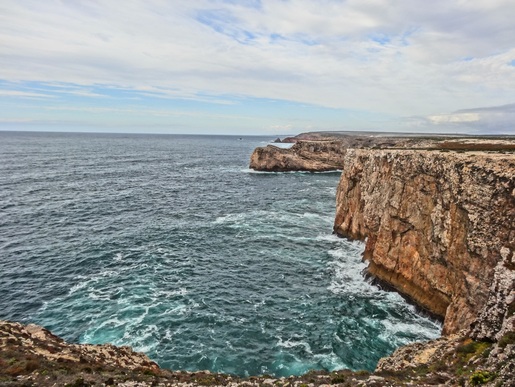 The Cliffs of Sagres Henry’s school accumulated the knowledge that would allow for this “edge” to be challenged. Through the development of an improved astrolabe, improved maps, and the new ship design of the caravel, he was able to send its students to places hitherto uknown in the world. Columbus studied there before getting sponsorship by Spain for his voyage to the New World. In 1488 Bartolmeu Dias was the first man to round the Cape of Good Hope and in 1498, Vasco Da Gama opened up the sea route to India, both after studying at Henry’s school.
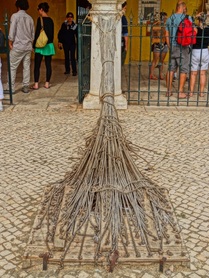 And yet the area has a nefarious past as well. For it was here in 1444, that Europe’s first Slave market (the Mercado de Escravos) was opened. From Lagos, thousands of Africans were dispersed through Europe, unjustly forced to perform labor after being snatched from their homes. The famously religious Prince Henry (who was part of the Order of Christ, deriving from the Knights Templar) received one-fifth of the selling price for each slave as he was the major sponsor of the expeditions to Africa. The image to the left depicts the front of the slave market, where ropes have been strung together to represent that first shipment of 275 slaves brought into Europe in 1443.
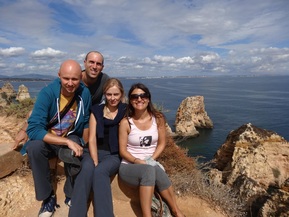 With these themes juxtaposed in our minds, we met up with some wonderful couchsurfers in Lagos who made our stay there truly memorable. Lijana and Andrius are Lithuanians who are traveling the world, living in different locations, and supporting themselves remotely with their website that sells Halloween Costumes (check out their site if you need a costume!). They were an inspiring couple to meet with as they took their wanderlust and made it into a viable profession while also generously sharing their home with surfers like us. But beyond serving us delicious vegetarian meals, they also picked us up from our hike along to the coast to the gorgeous Ponta da Piedade (the Point of Piety) and drove us up to Sagres, where we saw the cliffs that seaman for years considered the edge of the world.
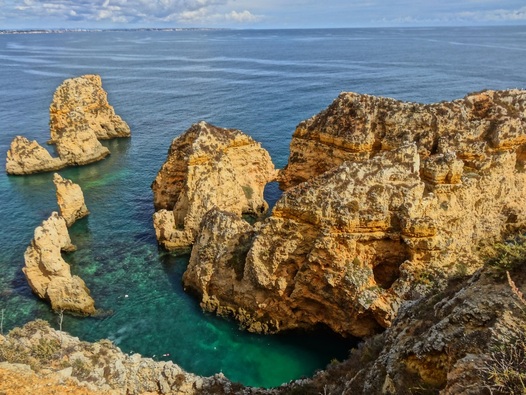 The views along the coast of the Point of Piety But after a quick photo where all the tourists were, we got to go a lot deeper. Adrius & Lijana are avid rock climbers and discovered some great routes just down on the famous cliffs. They took us to their favorite spot, an isolated cove where you can climb the sheer rock walls while the crashing waves and setting sun provides an utterly picturesque background (as you can see from our numerous photos and videos on our Flickr page). As we climbed at the edge of the world with our new friends, we felt a tinge of inspiration and trepidation that those long-gone sailors must have felt looking out into the unknown before setting off on their journeys. 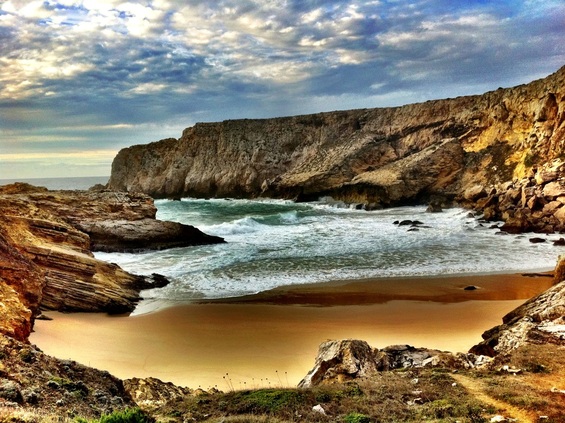 Our "secret" rock climbing cove - not far from where the tourists roam above... 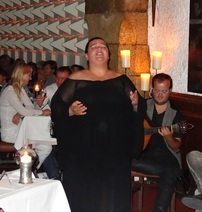 Fado Singer With so many sailors never returning from their journeys to the unknown, a musical art form known as Fado would eventually develop. Translated as “fate” Fado is a mournful, soulful style of singing where the singer bemoans the tragedies of the sea, unrequited love, and our inability shake loose from what fate offers us. Upon arriving in Lisbon, the capital of Portugal, we attended a Fado concert our first night to see what is all about. We enjoyed the music and the singers’ voices, though the current tradition of Fado is far from the spontaneous plebian singing that dominated the docks and taverns of old Lisbon. Rather, Fado is now sung in classy restaurants where a minimum amount of money must be spent to even sit down.
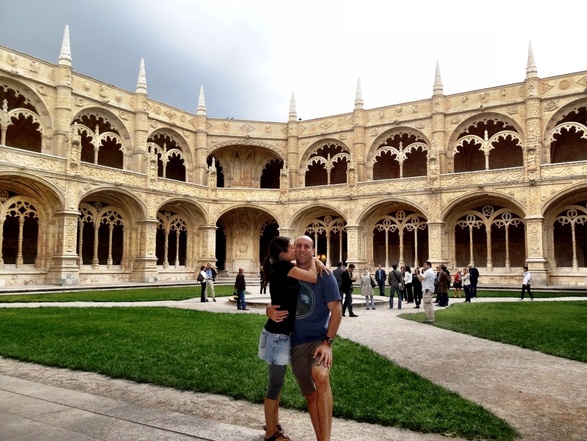 The Cloister in Jerónimos monastery - and I get to enjoy it far more than any monk did! The rest of our time in Lisbon was spent exploring the old neighborhood of Alfama, the gorgeous Manueline sea-inspired architecture of Jerónimos Monastery, Belem Tower, and the Monument to the Discoveries. The intricate detail work in the carvings of the cloister at Jerónimos Monastery were particularly impressive. We also filled ourselves up with fried cod-balls and sandwiches in the local food bars, an interesting cultural experience in which locals will eat a bite and a beer quickly at the bar rather than pay more to sit down at the tables outside. But in the end we grew tired of Portuguese food and were delighted to partake in some excellent all-you-can sushi restaurants that parlayed Lisbon’s wonderful seafood into delicious Japanese morsels at a fraction of the price of other areas we have traveled! 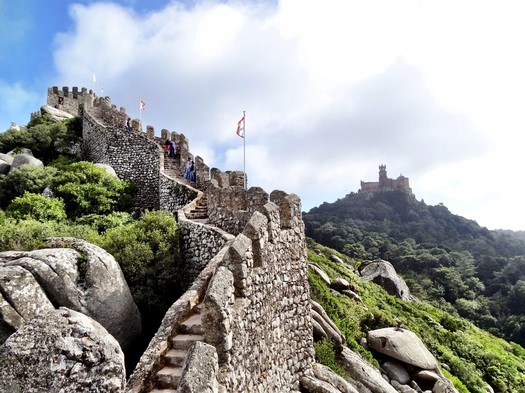 The Walls of the Moorish Castle with Pena Palace in the background On a daytrip from Lisbon we went out to the fairytale land of Sintra, which is overlooked by the remains of an ancient Moorish Castle dating from the 8th Century. But it is most famous for its two palaces: the Sintra National Palace and the Pena Palace. The Sintra National Palace was built on the site of another Moorish Castle, which was repurposed for the crown when King Afonso Henriques conquered Portugal from the Moors. It contains a mixture of Gothic, Manueline, and Moorish styles that makes for an interesting visit. 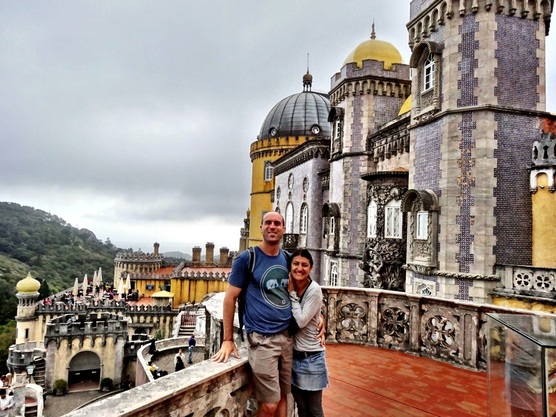 Pena Palace Afterwards, you trek up the hill (or take the tourist bus!) to the high walls of the Moorish Castle, overlooking the fairytale-like Pena Palace. Built between 1842-1854 by a German architect, the Palace resembles the castles sitting along the Rhine River, but with a Portuguese twist. It’s frankly garish color scheme wasn’t as beautiful as it was amusing for Neda and me to explore though one can’t help but be won over by the effusive charm of the place. See all of our pics from Lisbon and Sintar here. Our time in Portugal was packed full of sights, history, and new friends. We felt both inspired and saddened by the history of the place, and would soon feel tired as we hopped on the nightbus to Madrid to begin the last leg of our trip through Spain!
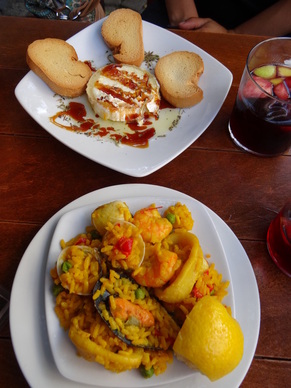 Paella, Baked Goat Cheese, and Sangria Our arrival in Seville (and into Spain) was immediately greeted by some of the best offerings of Spanish culture. As it was late at night, we found a cervezeria right outside of our pension that was serving ice cold “tinto di verano” (wine of the summer) and delicious tapas. We stumbled through the language barrier to get a plate of delicious Iberian ham (similar to prosciutto in texture and taste) topped with aged cheese and some delicious albondigas (meatballs in a savory sauce). The next day we continued this onslaught of delicious bites with little plates of saffron speckled paella, baked goat cheese covered in fresh marmalade, and salmorejo, a chilled tomato and bread soup topped with boiled egg and the aforementioned Iberian ham. What a welcome to Spain!
As we started to explore the city of Seville and learn about the region of Andalusia, we found that it wasn’t only our taste buds that would be excited. The rich history of the region leaves plenty of eye candy for even the casual observer. It all starts with Southern Spain’s rich Islamic history.
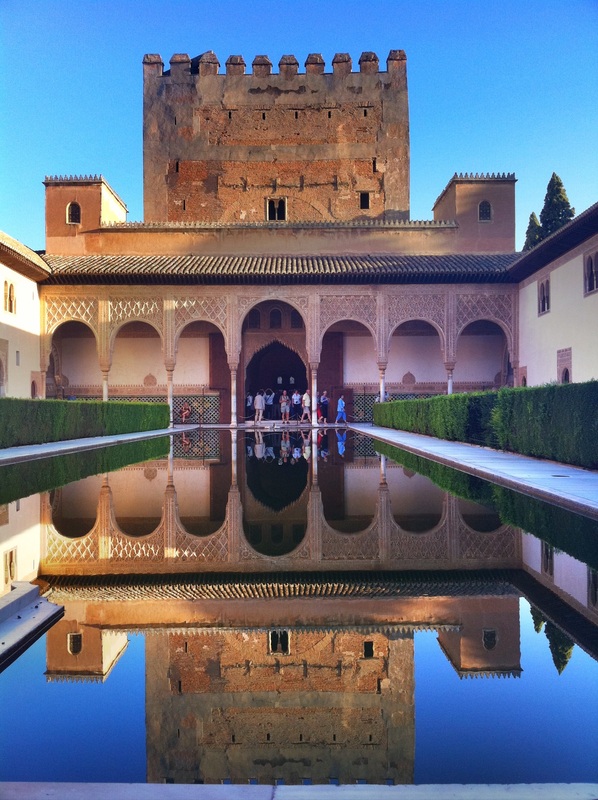
The Court of Myrtles in the Palacios Nazaries - Alhambra, Grenada
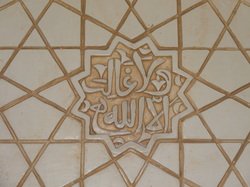 Arabesque Plasterwork In 711 A.D., Islamic leaders invaded the South of Spain (toppling the Visigoth empire that had temporarily ruled following the fall of Rome) and established the Kingdom of Al-Andalus, the root for the modern day territory of Andalusia. During their rule in Spain, the Islamic territories were a model of scientific research, artistic development, and religious tolerance (at least until 1100 or so). From the capital of Cordoba, the largest library in the world (at that time) was collected and massive investment went into the development of palaces and mosques, some of which still remain today. Islamic rule would continue strongly in the region until 1212, when North Catholic Kingdoms defeated most of the Muslim States established in Adalusia. The exception was the Nasrid Kingdom in Granada, which managed to last until 1492.
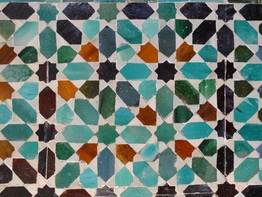 Azulejos - San Bartolome in Cordoba As we toured the palaces and mosques of Islamic Spain, we were awestruck by their use of simple substances like timber and plaster to create amazing décor in a style called arabesque. Imagine delicately carved plaster and carefully painted tiles (called azulejos) all coming together to form an endless interlacing of geometric forms. The Muslims believed that this stream of scrolling geometric patterns was an apt representation for eternity. Each piece is simple and beautiful in its own right, but when put into the context of hundreds of other pieces, the whole attains a beauty that the mind can barely begin to grasp. It’s a form of art that attempts to replicate how difficult it is for our finite minds to perceive something as vast and infinite as God.
We started our tour of Moorish Spain with the Alcázar of Seville, a fortress turned palace largely built in 1364, after the fall of the region to the Catholic armies. However, it was largely crafted by Muslim craftsmen from Granada and retains a strong Islamic flair. Perhaps most memorable for us was the domed ceiling in the Ambassadors Hall consisting of carved and gilded interlaced wood (see picture above).
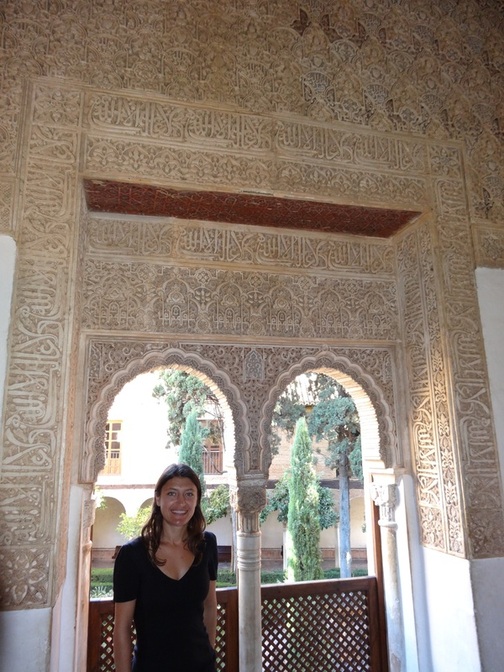
A typical window in the Alhambra
From Seville we traveled to Granada, home of the most fascinating of the Islamic relics – the Alhambra. Consisting of an old fort, a palace, and some of the most stunning palatial gardens we have ever seen, the Alhambra is truly a sight to behold. It sits perched atop a hill overlooking Seville and our morning climb to get into the Nasraid Palace at the appointed time already had our hearts beating in anticipation (and exhaustion ;)). The Nasraid Palace is a wonderfully preserved example of the arabesque style and we had to hold our jaws in our hands as we gazed upon its beautiful courtyards, throne rooms, and the geometrically inspired ceilings.
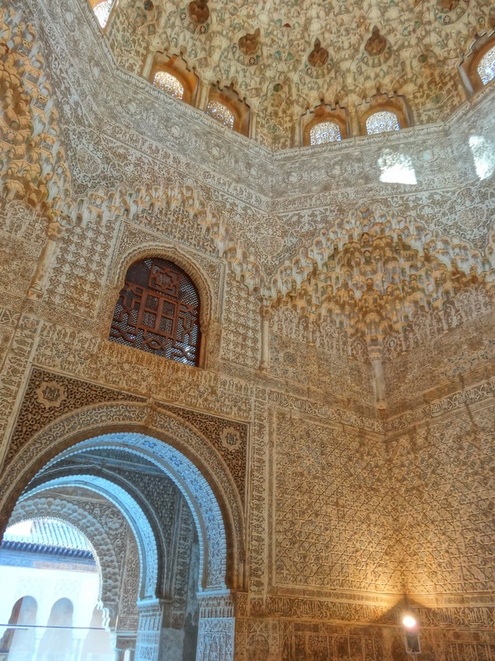
Hall of the Two Sisters in the Alhambra
An early morning bus ride took us from Granada to the former Moorish capital of Cordoba where explored the Mezquita, a mosque originally built in 786 to establish Cordoba as the heart of Al-Andalusa. The Moors used bits and pieces of the Roman ruins around the city to create a “forest of arches” that creates much the same effect as the geometric patterns discussed above. It is like walking through eternity – at once both humbling but also inspiring. Unlike the impersonal experiences we often feel in cavernous and cold Christian cathedrals, the Moorish architecture brought an intimacy and aesthetic focus on the abstract that was very appealing for us. Perhaps by avoiding direct representation of the infinite (like a person or thing), it allows the mind to stay soft and open for whatever experience it may have of something so beyond comprehension.
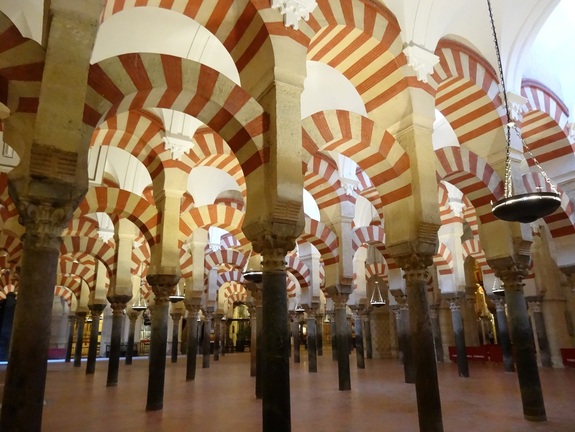
The forest of arches in the Mezquita
Unfortunately, the conquering Catholic royalty of northern Spain thought that it was necessary to tear down many of these mosques and build churches directly on top of them to express the domination of Christianity over Islam. In the case of the Mezquita, it was so large that the new rulers settled for putting an entire Cathedral in the middle of the Mosque. It is a very strange thing to see the Cathedral sitting there in the middle of the vast building. For the best illustration of it, see this video. 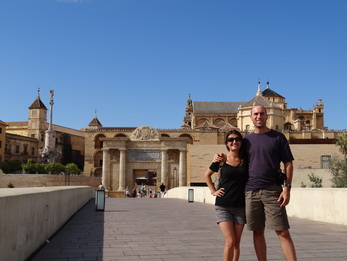 On the Roman Bridge leading to Cordoba For the Jews in Spain (known as Sephardic Jews), their fortunes changed with each conqueror. Jews were treated very poorly by the Visigoth’s who took over from the Romans, being forced to convert or leave the continent under their rule. When the first conquerors of Al-Andalus arrived, many Jews sided with them to get relief from the oppression. They were welcomed into Muslim society as dhimmis (non-Muslim members of monotheistic faiths). Their mastery of Arabic allowed for a golden age in which Jews held high positions in diplomacy, medicine, commerce, and agriculture. But as time went on, more conservative Muslim factions such as the Almohads took over Muslim Spain and Jews were forced to either convert or flee. Ironically, many did flee to the northern Catholic Kingdoms, who treated them well while they were needed to stabilize the government during the Reconquista (the battle by Christian royalty to retake Spain from the Muslims). But soon things would turn for the worse for Jews in Spain, as we’ll see when the blog post continues in Madrid and Toledo.
For the Iberian Peninsula, our story will start at the end of the journey rather than the beginning. Neda and I were sitting at a café in Barcelona at the end of a long travel leg that had taken us through Hungary, Croatia, Slovenia, Italy, Portugal and Spain over two months. The hotel refused to offer the luggage service they claim on their website, so we took our bags to the Barcelona History Museum where we saw the underground ruins of the 2,000 year old town of Barcino before settling into a café near Las Ramblas to have a bite to eat before taking the train to the airport. 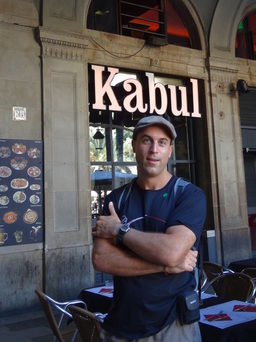 The scene of the crimes 10 years ago I was wary of being near Las Ramblas with our packs as this was the scene of the most traumatic travel experiences during my last trip through Europe ten years ago. At that time, I had my wallet stolen on the subway while my traveling companion had his camera stolen in a nearby hostel (pictured to the left) and I think another friend had theirs stolen on Las Ramblas. But we tucked our two backpacks close to our seats on the side away from the street and settled into some gazpacho and a ham and cheese baguette. At one point, the owner of the restaurant came by and said something to us in Spanish, pointing to our packs and then his eyes – reiterating the point of watching our packs. Why we didn’t secure the straps of our bags under the table, I don’t know, but we would soon pay the price.
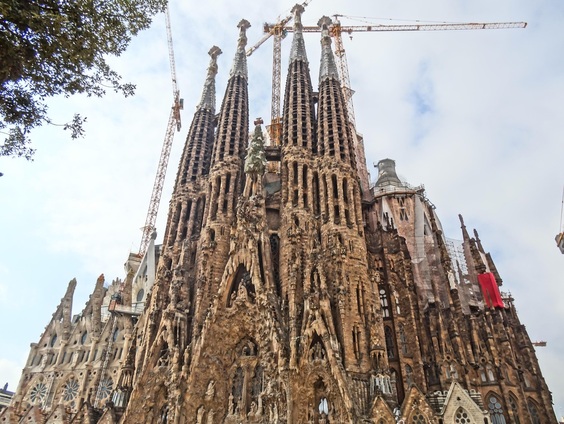 The Sagrada Familia - a seminal Barcelona sight by the famous architect Gaudi One of the roaming hoods we had seen around the restaurant, wearing a bright pink and blue collared shirt with red splotches all over his face, tapped me on the back and asked me some incomprehensible question in Spanish. I answered that I didn’t understand and then turned to Neda and asked if she had understood. She said no, and we continued eating while I patted my wallet and passport as my wariness increased. Then, one of the Englishmen sitting at the table piped up, “Hey there, I saw a hand near your rucksack there…”.
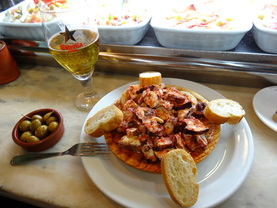 Octopus Tapas My eyes flashed over to our packs and sure enough, my black pack, with all of our electronics inside, was gone. I only had time for one “Jesus babe!”, before trouncing out of my seat and down the street. I didn’t know who had taken our packs, but it was clear that the guy in the neon pink and blue shirt was the “distraction man”. The pack was already out of sight, but I caught sight of the distraction man about 150 meters down the street, walking briskly away from us to avert suspicion. He was the last link to the bag that I had. If he got away, it was over. He was too far away to call for help – no one would understand what I was saying from that far and he could easily get away if he turned quickly and lost me.
At this point, he had the advantage of distance and knowledge of the city. But I had several advantages of my own. Firstly, we had bargained for a later checkout that morning and taken the time to do yoga for the first time in weeks – leaving me warmed up, stretched out, and primed for running. Secondly, I was wearing my trusty Clark walking shoes and not my loose fitting sandals that were ill suited for running. Thirdly, I was mad as hell.
I took off in a dead sprint, my knees pumping high in the air, people whizzing past me in a blur. Neda started running as well, but she hadn't had her sandals on at the time it happened and with her smaller barefoot strides she was quickly left behind. I saw the distance between us shortening to maybe 75 meters before the thief turned around and saw this Jew out of hell barreling towards him. He broke into a run and quickly cut to the right, out of my sight. But I was close enough to see where he had turned and banked after him. I found myself crossing a rounded stone arch through an empty courtyard with the thief just exiting at the other side. I was in time to see him bank left as I dashed through the courtyard, while my brain started to fully comprehend what was at stake. That bag was worth thousands of dollars to us, far more than the purely raw materials it contained. I ran faster.
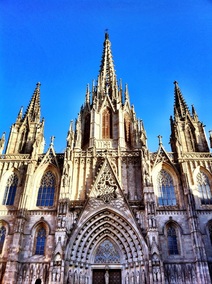 Barcelona Cathedral Once through the opposite gate I turned and was faced with two directions – straight ahead to the west or a turn right to the north. The thief wasn't in sight. Luckily, some old ladies walking down the street probably guessed what was happening and pointed me north, allowing me to lose little time in my pursuit. I sprinted up the alley to which they had pointed and came out to an isolated three way piazza with no sign of the distraction man. My heart was pumping and my legs were burning from the lactic acid that the sprint had produced. Each street of the intersection continued along for at least 50 meters without any turns – where could he have gone? How good of shape was the thief in? I had seen him slowing even through the courtyard and was sure I could catch up – unless he had some unseen doorway in which he could disappear?
The piazza was part of the old city of Barcelona with two and three story stone apartments silently observing my desperation. My eyes caught site of a dumpster in the northern corner and I ran over to inspect. Sure enough, the thief was huddled behind the dumpster trying desperately not to slow his panting. Too late. I grabbed him and raised my fist, but he slipped out of my one handed grasp and ran down the street. But it was over for him. Now I knew he had no weapon and I easily followed his tired gait, intending a football tackle to pin him down and find out the whereabouts of my bag.
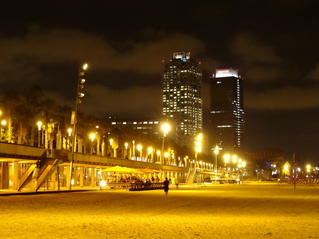 A latenight stroll on the beach A bit of luck prevented the need for any violence. As he ran away from me, he chose a street with 10 or 15 people walking in on our direction. I shouted for help telling everyone he had stolen my bag. A burly Australian (originally from El Salvador) was the first to answer my call, stepping in front of the greasy thief and prodding him backwards with his chest. Another man on a bicycle dismounted on the other side and we had him surrounded in a closing triangle. As I menacingly approached, demanding the bag, he fumbled for his pockets, pleading for a moment to call his fellow bandits. I asked the guys to call the police regardless, but while they had their phones out pretending to dial, to my dismay I later found out that neither of them had the number to call! The thief made his call and led us up a nearby street where one of his outfit was waiting, but without my bag. Then I turned around and there, walking up the street leisurely with a grey collared shirt, a man approached with my bag on his back. A surge of relief went through me as I ran over to the man and stripped the bag off of him.
With the bag in hand and police nowhere to be found, the thieves slipped away as I turned to thank those who had come to my aid. The Australian’s girlfriend had walked along with us at a distance as well and they walked with me as I tried to find my way back to Neda. I was worried that she had run off – leaving her bag unattended and open to a possible double theft. While we walked, I found out the couple’s name – Walter and Simona and was in for a quite a surprise when I found out that Simona was from Stara Zagora – the town where we live (and Neda is from) in Bulgaria! It felt great to see a Bulgarian in this town full of madness and they were kind enough to walk all the way back to the café with me, where we found Neda (with her shoes this time) heading up the street in search of us. Neda described her amazement when she saw me strolling back down the street with the black straps of my bag secured snugly around my shoulders. Against the odds – we had successfully run with the thieves in Barcelona!
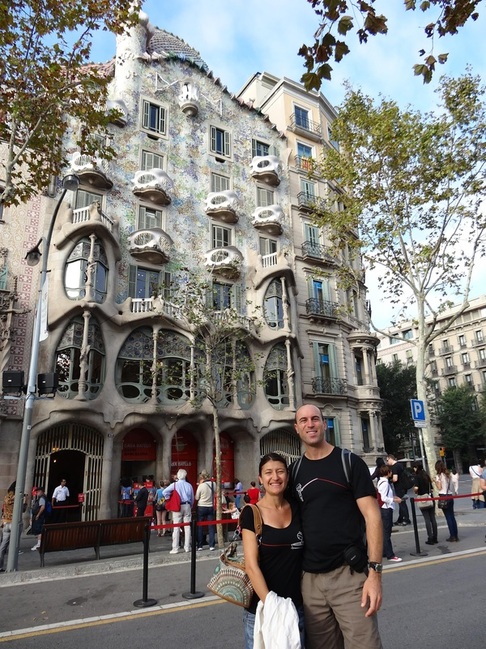 In front of Gaudi's famous Casa Battlo I named the post after the famous “Running with the Bulls” in Pamplona Spain because it reminded me of a passage I had recently read in Pema Chödrön’s “When Things Fall Apart – Heart Advice for Difficult Times” about the eight worldly dharmas – or pairs of opposites that hook us (like the horns of the bulls in Pamplona) into either pursuing them or trying to avoid them. These pairs are pleasure and pain, gain and loss, fame and disgrace, and praise and blame. When we respond to them in our normal conditioned ways, we strengthen our false sense of self while creating distance from the world around us. Chödrön writes: “We might feel that somehow we should try to eradicate these feelings…A more practical approach would be to get to know them, see how they hook us, see how they color our perception of reality, see how they aren’t all that solid. Then the eight worldly dharmas become the means for growing wiser as well as kinder and more content…
When we become more insightful and compassionate about how we ourselves get hooked, we spontaneously feel more tenderness for the human race. Knowing our own confusion, we’re more willing and able to get our hands dirty and try to alleviate the confusion of others. If we don’t look into hope and fear, seeing a thought arise, see the chain reaction that follows – if we don’t train in sitting with that energy without getting snared by the drama, then we’re always going to be afraid. The world we live in, the people we meet, the animals emerging from doorways – everything will become increasingly threatening.”
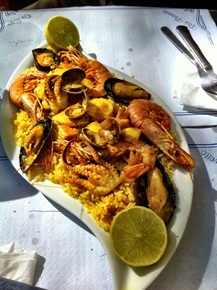 Paella! Our encounter with the thieves in Barcelona could lead us two ways. If we get hooked by the horns of fear, loss, and blame then we begin to hate the thieves, hate the city that spawned them, and close ourselves off to a world that is full of injustice, greed, and the pain that fuels them. If we just sit as the bull charges, watching the horns with curiosity and openness – then before the horns find our flesh, a tenderness towards our assailants arises that deflects the blow. Of course the thoughts of anger will arise, but if we watch them instead of following them, those thoughts become our guides towards contentment rather than our tormentors of continually re-hashed negative stories.
I’ve spent 6 days total in Barcelona and have been robbed twice – the only two times in my life in fact. Despite the wonderful Gaudi architecture, charming old city, and lively people, Barcelona seems to always present challenges to the illusion of security and stability that I find myself walking around with most of the time in life. And for this gift, I bow graciously to the city – even if I won’t be returning anytime real soon :).
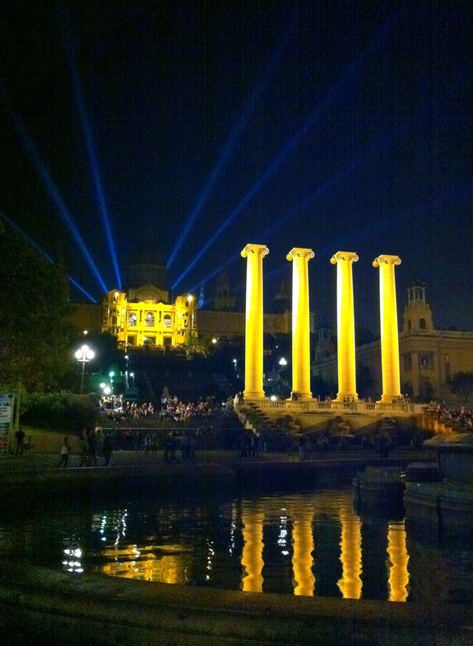 Magic Fountain with Museu Nacional d'Art de Catalunya As I mentioned, this post is out of chronological order. We are in Bulgaria now and I will be posting the rest of Spain and Portugal in their proper order: Andalusia followed by Portugal, followed by Madrid and environs. Barcelona was our last stop, but this story was fresh and had to be told!
Heading south from the Bay of Naples and the Amalfi Coast we trained down to the largest island of the Mediterranean Sea – the infamous Sicily. Sicily is a fascinating blend of cultures, which has at various times been ruled by Phoenicians, Greeks, Romans, Arabs, Normans, Spaniards, and the French. This gives it a complexity of character that we would discover was much different from mainland Italy.
At the crossing from the mainland, the train disconnects and boards the underbelly of a giant ferry before unloading on the other side! In a hostel in Palermo we were talking to some younger travelers, one of whom had fallen asleep during that part of the trip. He asked us, “how did we get across to Sicily? Someone told me there was a massive bridge across.” We all had a good laugh, though frankly before the crossing I didn’t realize that trains could just roll onto ferries so easily!
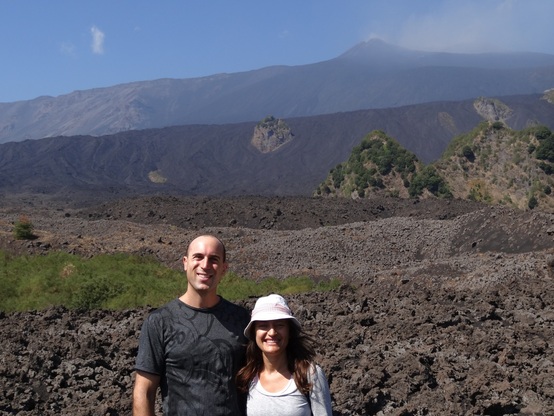
Jeff and Neda under the looming Mount Etna, Europe's tallest active volcano - note the dried lava on the ground around us!
Our first stop off the train was in the volatile city of Catania. Nestled at the bottom of the tallest volcano in Europe and one of the most active in the world, Mt. Etna, Catania seems to derive its frenetic energy from the liquid fire that occasionally shoots into its skies. Pulling into town also brought back fond memories of one of my favorite shows growing up, The Golden Girls! Sophia is from Sicily and would often tell stories about Mount Etna and its eruptions. It’s funny that coming into the home of the Mafia you would think I would have the “Godfather” more on my mind, but instead I kept thinking of Sophia!
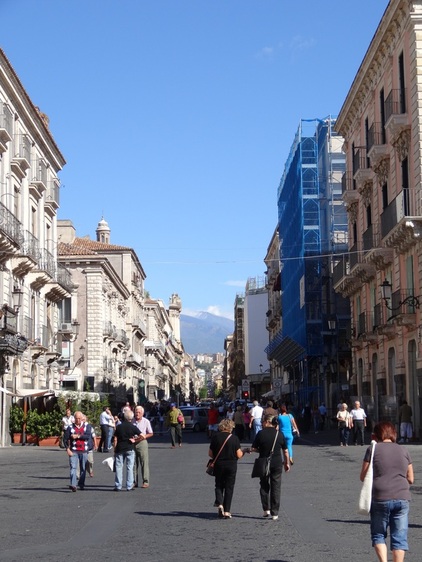
Catanians walk through streets built of volcanic rock while Etna sits in the distance
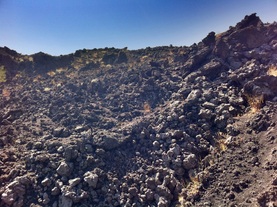 Etna Lunar Landscapes While in Catania, we marveled at how much of the town was built from the igneous rock that spurts forth from Etna every few years. In 1669, the eruptions were so severe that magma wiped out a large part of the city. Citizens then took the cooled magma and incorporated it into their city – the cobblestones on the streets and blocks of their buildings. We took a tour of the region around Etna, gaping at the 3300 meter high volcano while walking around the lunar landscape of hundreds of craters that have formed from eruptions over the years. We walked through tunnels created by the lava flow and learned about how the people of Catania cope with this looming threat over their homes by fully embracing it.
The Catanians recognize that Etna is a danger to them at any moment, but they also appreciate the incredibly fertile soil that she provides and the mortar she produces from which they can build. We found it inspiring how they bring forth fertility from such destruction. A product of that fertility is the delicious wine they produce in the region from the Nerello Mascalese, Nerello Cappuccio and Nero d'Avola varietals. Another delicacy is the sweet eggplant, used to make dishes like “Penne alla Norma,” or penne with tomato sauce, eggplant, and salted ricotta cheese.
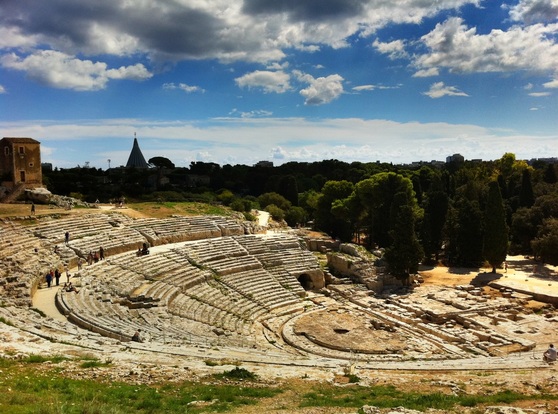
The Greek Theater in ancient Syracuse - dating from the 5th - 3rd century BC
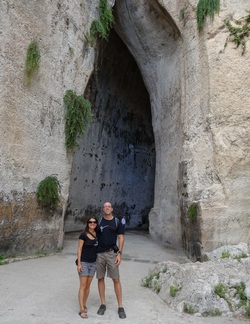 The Ear of Dionysius From Catania we headed south to Syracuse, one of the strongest cities of Ancient Greece and a competitor with Athens during that time. We spent just one night exploring the ancient ruins of the Greek city slightly outside of the town as well as in the small island of Ortygia, where the ancient city has been built over by generations of successive conquerors. Outside the city lies a beautifully preserved Greek theater, where the famous playwright Aeschylus is said to have premiered some of his tragedies. There is also an old stone quarry of the ancient town, which was used as a prison. It is famously called the “Ear of Dionysius” because the tyrant king is said to have listened to his prisoners speak from above via the chamber's well tuned acoustics.
But perhaps the most interesting part of the city for us lay in the city’s Jewish history. In 1492, when Isabelle and Ferdinand completed the reconquest of Spain from the Moors, they also decided to expel all Jews from Spanish territory (which Sicily was at the time). A that point, the Jews had been a vibrant part of Syracuse’s history for nearly 1000 years so their forced removal was a gross injustice, albeit only the final one in the history of the Jews in Sicily (read more Jewish history in Sicily via the preceding link).
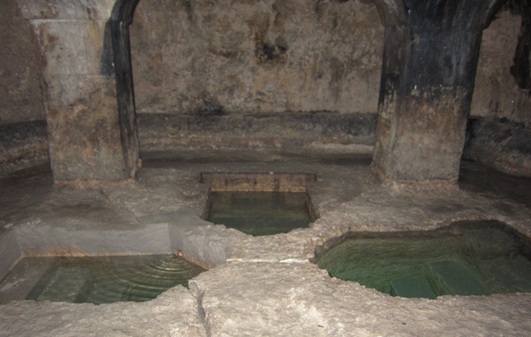
The recently discovered Mikvah 18 meters below the city streets of Syracuse
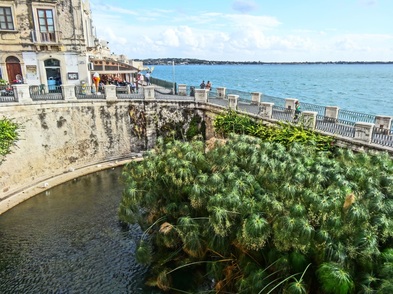 The Fountain of Arethusa overgrowing with papyrus plants Fast forward to 1994, nearly 500 years later, when the foundation of a building was being renovated to be made into a hotel in Syracuse. While digging, workers uncovered the remains of a mikvah, or ritual Jewish bath 18 meters below the ground that dated from at least 600 AD. When fleeing the city, the Jews had buried the mikvah (it took 5 truckloads of dirt to dig it out), most likely to prevent sacrilege from occurring there and in hopes of one day returning. The mikvah, believed to be the oldest in all of Europe, was used for ritual baths by both Jewish men and women. For women, they would fully immerse themselves after certain occasions like end of a menstrual cycle, after giving birth, and before marriage. The men would use it to clean themselves in preparation for the Sabbath. On an island surrounded by salt water, the Jews found an old Greek well that was fed by a freshwater spring to which to connect the mikvah so that within 24 hours all the water from a ritual bathing would be fully replaced by fresh water. It is believed that this underwater spring may also feed the famous Fountain of Arethusa located nearby on the island. It was amazing to learn how the entire mikvah chamber had been carved only with a hammer and a chisel, a remarkable achievement for the time. For us it showed the Jewish people’s dedication to this sacred place and also the connection to the land that we had also noticed in the people of Catania. Click here to read more about the mikvah.
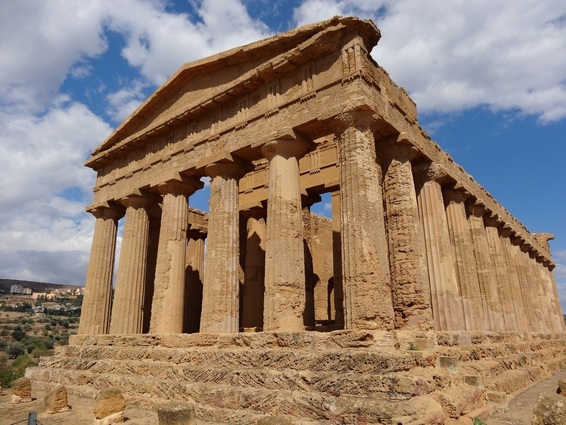
The amazing Temple of Concordia in the Valley of the Temples
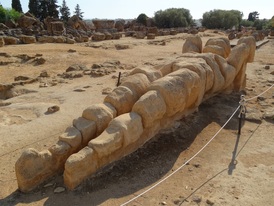 The telamons From Syracuse we stopped for a night in Lentini to meet up with Lucio, a gracious Couchsurfing host who made us a homemade Sicilian meal and told us stories of the life in Sicily. Then we headed west to Agrigento, where more Greek ruins awaited in the stunning Valley of the Temples. The valley houses the remains of 5 Greek temples built along the ridgeline of the island to honor the Gods and greet homecoming sailors. The most preserved Temple of Concordia dating from the 5th century BC shoots one back in time to when Agrigento was a prosperous city-state engaged in trade and continuous war with the regions surrounding it. The more ruined Temple of Hercules measures about the size of the Parthenon in Athens while the completely destroyed temple of Jupiter would have been even larger! That temple featured giant “telamons” between its Doric columns which held up the ceiling of the enormous temple. In the town of Agrigento itself, which sits high above the valley, we enjoyed climbing through its winding streets and sampling some fresh Sicilian treats (including a very unique pistachio cous cous) from the nuns at the Monastero Santa Spirito.
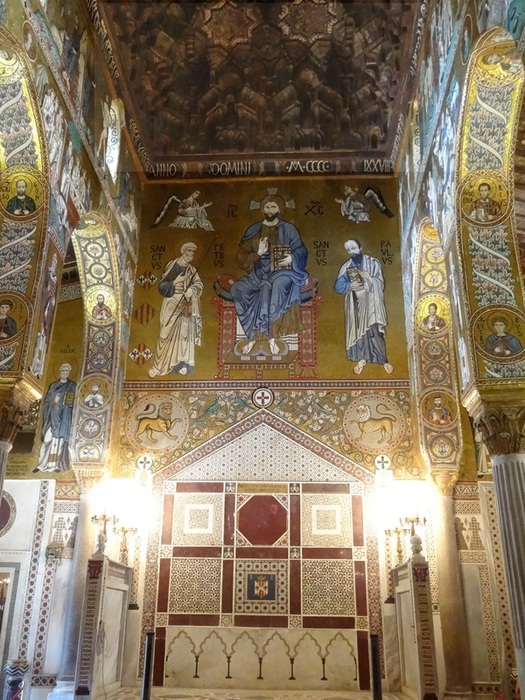
The altar of the Capella Palatina has Byzantine (note the gold mosaics), Arabic (note the geometrically intricate carved wooden ceiling), and Norman influences (the barely visible Romanesque columns on the sides)
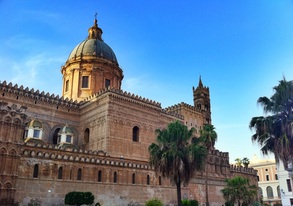 The Cathedral in Palermo We traveled north by train from Agrigento to Palermo, capital city of Sicily and fictional home of Sophia. Palermo is a fascinating city because it still retains traces of its Arabic heritage in addition to its Greek, Roman, and Norman influences. Palermo was an Arab city from 827 to 1071, after which the Normans managed to conquer it back and make it a part of the Byzantine Empire. We found the Cappella Palatina there to be a foreshadowing of our trip through Southern Spain with its heavy Arab Influence. Cappella Palatina, housed within the Norman Palaces built after the conquest (Palazzo dei Normanni) is a perhaps the most stunning mixture of Arab, Norman, and Byzantine art in the world. It combines beautiful golden Byzantine mosaics with muqarnas (Arabic style) ceilings and Norman doorways. The Norman Palaces were a snapshot of the opulence enjoyed by the ruling families of Sicily over the years.
But the most infamous ruling families in Palermo are still very much present, though their power may be waning. The Mafia was born out of Sicily’s transition from feudalism to private landownership. When Italy annexed Sicily in 1860 it redistributed much of the land to private landowners, but newly formed authorities didn’t have the manpower or experience to enforce property rights and protect property from bandits. Thus were born the first mafia clans. The necessary evil of “protection” would later become a lucrative racket where local merchants had to pay for the protection of their businesses or suffer from the very people they refused to pay. We were surprised to learn from locals that 70% or more of the businesses in Palermo still pay for this protection – proof that the perception of the waning power of the mafia in the area may be fictitious.
Luckily, we didn’t have any run-ins with the mafia other than the stories about protection that the locals told us. When we asked one local what happened if you don’t pay protection he said, “first you just get wax or glue in the keyhole of your door. That is your first warning. If you don’t pay after that some accident will happen to your business – a fire or a burglary perhaps.” Makes small business in America seem a lot simpler, huh?
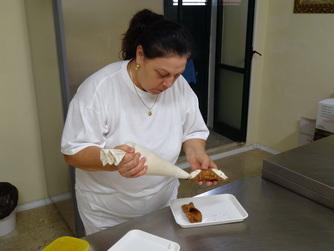 Fresh cannoli! Other than talking mafia and visiting churches we spent our time in Palermo doing what we enjoy the most – searching for the local dishes. We went on a persistent hunt through the Mercato di Ballaro looking for the “Fabrica di Cannoli,” a family owned cannoli kitchen that supplies many restaurants with their cannoli. They have a small kitchen where you can get individual orders of the delicious desert and watch the freshly made ricotta and chocolate mix squirt into the fried cannoli shell. It’s like a delicious bite of heart attack! Neda also started to fall in love with eggplant as we enjoyed eggplant parmigiana and numerous other preparations of the nightshade. We ended our stay with a tasting of the local pasta con sarde, which is spaghetti with minced sardines, fennel, pine nuts, and raisins. Certainly one of the most interesting pasta dishes we had, though not at the top of our list to try again!
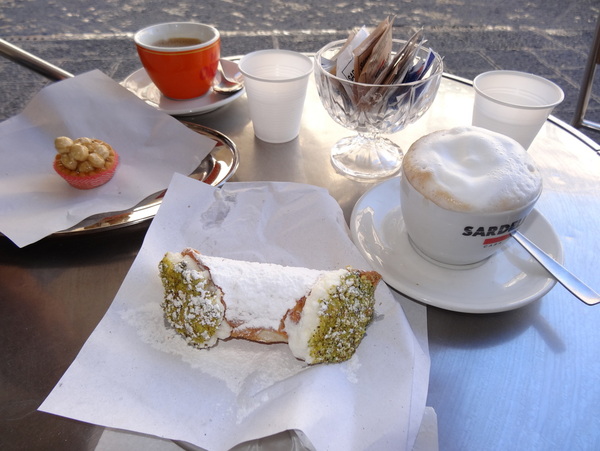
Ahh memories of Sicily - freshly made cannoli and a cappuccino :)
All in all, Sicily was a experiences in extremes. Noisy streets and even nosier people. Flavorful foods and wines and enough history to leave even the biggest buff bewildered. We loved our time there, but it was time to say goodbye to Sophia’s home and board the plane from Palermo to Seville to start our Andalusian explorations! A final quote to leave you with: Rose: Did you know they have an egg named after you Blanche? Blanche: Oh really? How is it prepared? Sophia: Over easy. To see all the pics of Catania and Syracuse, click here: To see all the pics of Agrigento and Palermo, click here:
|


















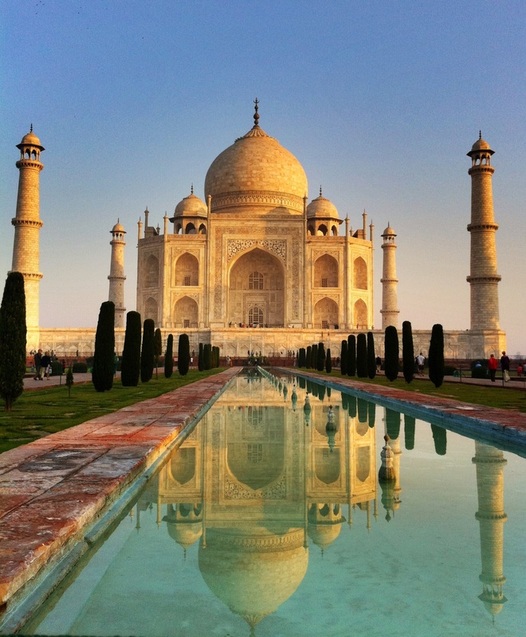
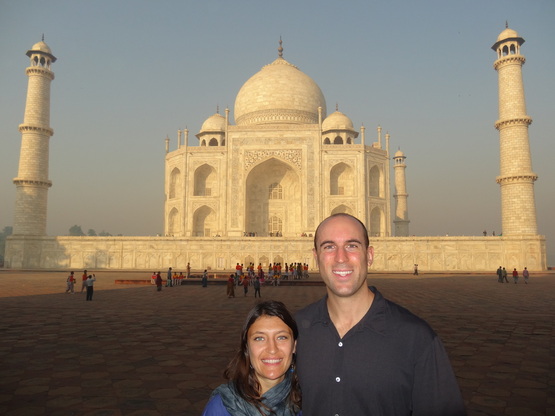



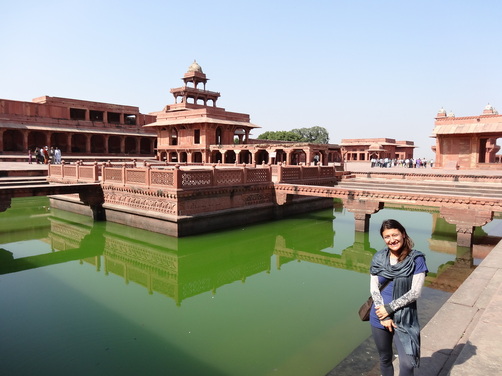




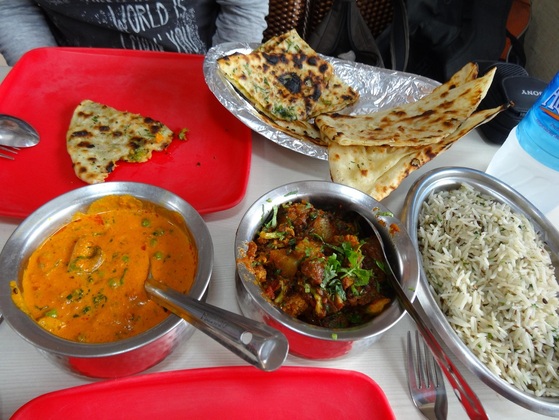






















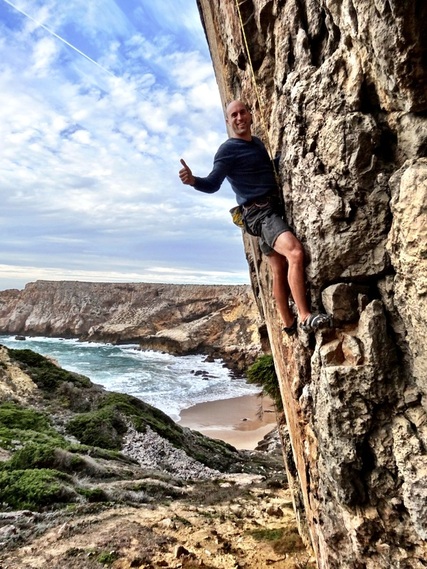













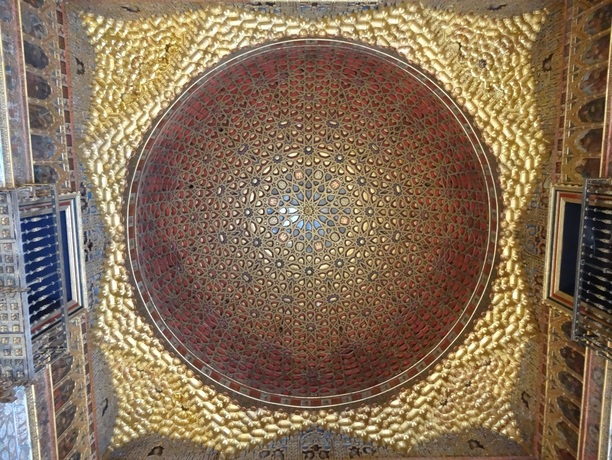




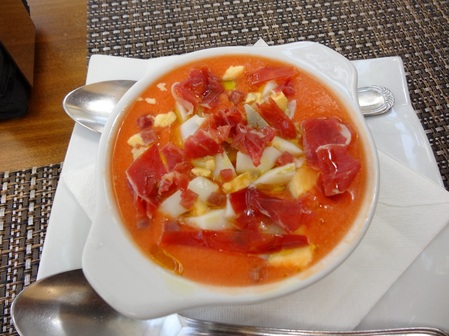








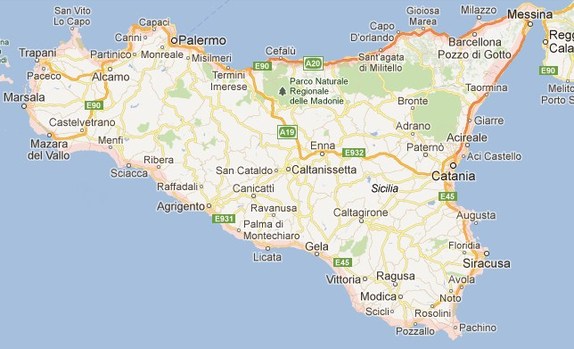













 RSS Feed
RSS Feed